
By Ebony JJ Curry SENIOR REPORTER



By Ebony JJ Curry SENIOR REPORTER

By Ebony JJ Curry SENIOR REPORTER
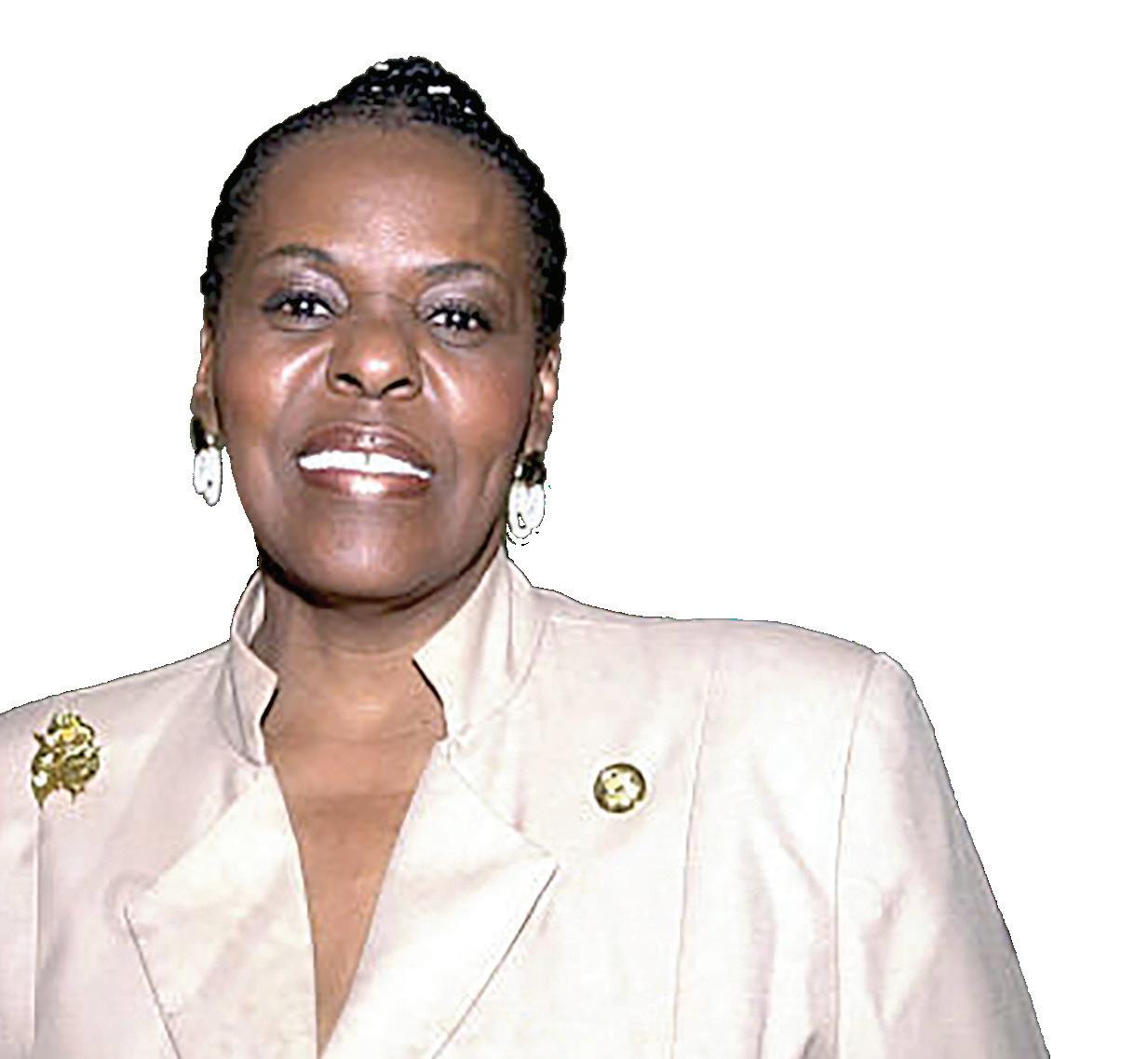
14, a historic moment unfolded in American labor relations as the United Auto Workers (UAW) union initiated a strike against Ford, General Motors (GM), and Stellantis. For the first time, the union took simultaneous action against all three major Detroit-based automakers. The action involves approximately 13,000 UAW members in assembly plants across Michigan, Ohio, and Missouri, who walked off their jobs after existing labor contracts expired at 11:59 p.m.
Sept. 14, GM released a statement expressing disappointment with the strike action, despite offering what it termed an “unprecedented economic package” that included historic wage increases. Stellantis
40 Under 40 event Thursday evening. This year’s soirée, drenched in the theme “All Black Everything with Gold Accents,” transcended expectations and essential ly illuminated the golden gems within the true essence of Black excellence. Hosted by the charismatic duo of Andre Ash and Lynzee Mychael from Michigan Chroni cle’s Finally Friday, the night was a triumph for the city of Detroit and its vibrant community of young Black professionals.
The evening sparkled with a golden promise as we celebrated remarkable individuals from various walks of life. Among the honorees were the brilliant and vi sionary co-founders of Detroit Hives, Nicole Lindsey and Timothy Paul Jackson. Their work has not only changed the landscape of beekeeping and urban farming in De troit but also exemplified the transformative impact Black professionals can have on their communities.
also expressed disappointment in a statement, saying the company immediately went into contingency mode to protect its operations.
“Together we have created a social, environmental, and financial impact through bees,” said Jackson. Lind sey followed that sentiment with, “It is through our local partnerships and collaborative efforts that we exist in over 28 plus locations managing the health of 4.5 mil lion honeybees – humbly speaking our movement has inspired others locally, nationally, and even internationally to take on similar missions.”
By Ebony JJ Curry, Senior Reporter, & Jeremy Allen, Executive Editor

Dreceived the prestigious Entrepreneur of the Year Award. Brown’s commitment to empowering the city through fashion and entrepreneurship has left an indelible mark.
niably commendable.
Amidst the glitz and glamour, the event also showcased the diversity of talent within our community. From Paris T. Prichard, a forensic scientist pushing the boundaries of her field, to math wizards like Donna Laster, who
etroit is mourning one of its most formidable daughters — a woman whose voice carried from the classroom to Congress, from the streets of Detroit to the halls of power in Washington. Carolyn Cheeks Kilpatrick, the trailblazing former U.S. congresswoman and lifelong educator, died Tuesday, Oct. 7, at age 80. Her passing marks the loss of a political leader whose legacy is woven into the very fabric of Black progress in Detroit and across the nation.
“Entrepreneur of the year – that’s a big deal,” said Brown. “It’s always an honor to be honored and it’s always a blessing to be in a room full of so many talented, accomplished, and popular people that look like me. I’m geeked. I started making and selling clothes as a kid and I always knew that I would have a business, but I never knew it would be Detroit’s brand name business, so I take a lot of pride in the fact that our business rep-
Her family announced her passing on Wednesday, Oct. 8, calling her “a tireless warrior for Detroit and an unwavering champion for her constituents.”
“For over 32 years, Congresswoman Kilpatrick held elected office with passion, integrity, and an unyielding commitment to bringing positive change to our community,” the family said. “She will be deeply missed, not only by her family and friends, but by the entire Detroit community that she loved so dearly.”
Taking home the Corporate Excellence Award was Dannis Mitchell, Director of Community Engagement at
Greektown Had 1.4 Million Visits This Summer and No Shootings
DPD Chief James White Says Increased Police Presence Culled Violence By Andre Ash
DIGITAL ANCHOR
ness district that had been the lifeblood of
Kilpatrick’s name was synonymous with service and purpose. A proud Detroiter and former Detroit Public Schools teacher, she began her career in education before winning election to the Michigan House of Representatives in 1978. She served nine consecutive terms there, a record that reflected her discipline, intelligence, and deep connection to the city’s people. Her early legislative work focused on workforce training, equity in education, and creating fair access to state resources for working families.
ever, there’s a deeper, far more troubling story beneath the surface of this seemingly
Detroit Hives, a pioneering organization founded by Lindsey and Jackson, harnesses the power of urban beekeeping to revitalize neighborhoods in the Motor City. Their initiative not only addresses critical issues like environmental conservation but also provides valuable education and employment opportunities to Black De
The UAW has branded the industrial action as the “Stand-Up Strike,” focusing on specific plants within each automaker. UAW President Shawn Fain stated, “This strategy will keep the companies guessing. It will give our national negotiators maximum leverage and flexibility in bargaining. And if we need to go all out, we will. Everything is on the table.” Union leaders have also indicated that additional plants could be targeted in future waves if negotiations remain stalled.
“It is so important to recognize that there are young leaders across the country, many that are born here in Detroit. I represent our city nationally and I tell people, ‘Yea I’m a D-girl I’m from the west-side of Detroit,’” Mitchell expressed. “But more importantly, I’ve been able to have experiences within an industry that not many of us, specifically women of color, have the opportunity to engage in and I’ve been the youngest person in the room, the only Black person in the room, and the only Sistah in the room, and I really had to articulate the importance of showing up, giving chances when others won’t, and being persistent.” As a trailblazing Black woman thriving in a predominantly male-dominated industry, her unwavering commitment to fortifying the connections between businesses and Detroit’s communities is unde-
It’s a history marred by pain, injustice, and economic devastation. More than 130,000 residents, primarily Black, were forcibly displaced. Families were uprooted, generational wealth was obliterated, and a thriving community was torn asunder. The wounds inflicted by I-375 run deep, transcending the physical barrier of a freeway to penetrate the very soul of Black Detroiters.
towards mending the wounds inflicted on Black Detroiters and restoring a sense of belonging that was so callously torn away in the past.
The I-375 Boulevard Project is about more than just correcting historical injustices; it’s about redefining the future. It will connect downtown Detroit to surrounding neighborhoods, bridging the gap that was placed upon the city decades ago.
When she rose to Congress in 1996, Kilpatrick became only the second Black woman ever elected to the U.S. House of Representatives from Michigan, representing the 13th Congressional District. The district encompasses families, business owners, union workers, and generations of Detroiters who shaped the city’s resilience and culture.
This painful legacy can be traced back to the nation’s interstate highway program of 1956—a program that aimed to connect the country but often did so at the expense of marginalized communities. In the case of I-375, it meant carving a path through the heart of Black Detroit, reinforcing segregation, and perpetuating inequality.
By Andre Ash DIGITAL ANCHOR
Fain clarified the union’s strategy: “I want to give a major shoutout to the thousands of members who are on the picket lines right now fighting for all of us. The Stand-Up Strike is a new approach to striking. Instead of striking all plants at once, select locals will be called on to stand up and walk out on strike. This is our generation’s answer to the movement that built our union – the sit-down strikes of 1937. We told the Big 3 that Sept. 14 was the deadline and we meant it. We gave the companies our economic demands eight weeks ago and it took more than a month to get to the table.”

A string of shootings in Greektown in mid-April left both visitors and residents of this bustling downtown destination in awe. One of these shootings tragically claimed the life of a popular and beloved security guard following a dispute with a patron. The male suspect allegedly shot the guard before fleeing the scene, while his female companion is accused of concealing the weapon in her bra.
From the beginning, Kilpatrick treated public office as an extension of community service. By her second term, she had earned a coveted seat on the House Appropriations Committee, one of the most powerful assignments in Congress. There, she secured more than $1 billion in federal aid for Michigan, funding programs that ranged from job training and university research to public transportation and hospital improvements. Her focus was always on translating federal power into tangible results for her district.
A Holistic Approach to Providing Shelter and Support for Detroit’s Unhoused People
Homelessness continues to plague urban communities, with families and individuals grappling with the challenges of making ends meet in today’s economic climate. Whether it’s struggling to meet monthly mortgage payments or coping with soaring rental costs in a housing market marked by shockingly high prices, a variety of factors contribute to the growing issue of people becoming unhoused.
Housing Resource Helpline in response to the challenges that residents face in navigating the complex system of housing services. The helpline provides a single point of contact for people seeking housing assistance and connects them with the resources
The union is pushing for a comprehensive list of demands. This
Historically, shelters have provided a temporary respite for those in need, often serving as the first or second option after exhausting alternatives like staying with friends or family. Shelters offer a place to rest one’s head and a warm meal, albeit sometimes for extended periods. For others, being unhoused means living in cars or makeshift outdoor settings.
The causes of homelessness are as diverse and complex as the individuals experiencing it. In response, the City of Detroit has adopted a holistic approach to combat this issue.
“Providing services and high-quality housing to persons at risk of or who are experiencing homelessness is a key priority of the City of Detroit, said Julie Schneider, Director of Detroit’s Housing and Revitalization Department.
“This means focusing on building the pipeline of supportive housing and coordinating with the Continuum of Care on the delivery of critical resources such as emergency shelter, rapid rehousing, and diversion and prevention programs. It also means preserving and expanding affordable housing options for Detroiters of all incomes and improving housing stability though comprehensive service offerings available through the Detroit Housing Resource HelpLine and Detroit Housing Services Division within HRD.”

Street, too, was obliterated a few years later, making way for the construction of I-375. This marked the final blow, sealing the fate of Black Bottom and signaling the beginning of the end for Paradise Valley, the Black busi-
In May 2023, the City of Detroit launched the Detroit

These incidents unfolded during an unseasonably warm spring, leading to increased pedestrian traffic and heightened tensions in the densely populated downtown area.
For one to aptly recognize the harm caused by such projects, it is vital to note that some of the planners and politicians behind those projects built them directly through the heart of vibrant, populated communities—oftentimes to reinforce segregation and sometimes as part of a direct effort to replace or eliminate Black neighborhoods.
Today, the resurgence of Paradise Valley stands as a testament to the indomitable spirit of Black Detroiters and the enduring legacy of Black excellence. This historic district, once a vibrant hub for Black businesses and culture, is experiencing a renaissance that harkens back to its glory days. The destruction of Black Bottom may have torn apart a thriving community, but the resolute determination of a new generation of entrepreneurs and visionaries is reclaiming that lost legacy.
The surge in crime and the influx of visitors to Detroit’s downtown core garnered the attention of the Detroit Police Department (DPD), catching them somewhat off guard.
“She was a hard-working congresswoman,” recalled former Detroit Mayor Dennis Archer Sr., who led the city during her early years in Congress and shared a close, collaborative friendship with her. “She worked hard, she cared about her city, and she cared about her congressional district. She was very well thought of.”
But now, after decades of enduring the scars of I-375, there is a glimmer of hope on the horizon. Plans have been unveiled to transform this once-divisive freeway into a vision that seeks to right the wrongs of the past while heralding a new era of inclusivity and community revitalization.
Archer said their relationship was grounded in mutual respect and shared purpose. When Kilpatrick first arrived in Washington, he helped connect her to key figures who could help amplify her impact. “When she came in, she had an interest in serving on a couple committees,” he said. “I made a couple suggestions as to who she might call. I knew some folks who could make what she
Support for the helpline comes from the Gilbert Family Foundation, which has pledged $10 million over three years to fund the program. Wayne Metro Commu-
all Detroit residents. This initiative simplifies access to the City’s various housing services, ensuring that residents in need can easily find assistance.
“The city and its partners offer a lot of great services to help Detroiters with their housing needs, but they don’t mean much if people don’t know how to access them,” said Mayor Mike Duggan. “Thanks to the efforts of our partners and the generous support of the Gilbert Family Foundation, we now have a simple process to guide residents to the right housing resource and a growing number of programs to
The Gilbert Family Foundation’s broader commitment involves pledging $500 million to support projects across Detroit over the next ten years, with housing initiatives being a significant part of their contribution.
Notably, Detroit has witnessed a consistent decrease in recent years, with the number of unhoused residents steadi ly declining. In 2019, approximately 7,847 people were unhoused and entered the City’s community response system. In 2021, about 5,687 people experienced homelessness.
According to the City of Detroit, since the start of the fiscal year 2019 to 2021, Detroit saw a 28% decrease in the

James White, Chief of Police for the Detroit Police Department, said: “We were caught somewhat flat-footed right out the gate. By design we went into the spring deployment, which is less than the mid-summer deployment, and saw we say an uptick in violence that first warm weekend.”
Chief White attributes the violence in Greektown to a combination of weather conditions and a surge in population.
Fueled by more than $100 million from the Infrastructure Investment and Jobs Act
He explained, “ We saw numbers downtown that we have not seen, ever. People are emerging from COVID and there’s a feeling that we’re in a post-COVID era… and with the venues downtown and the reasons to come down with all the activities that are going on, we saw hundreds of more people and, in particularly, young
In the heart of Paradise Valley, Blackowned businesses are not just flourishing but thriving, offering diverse services, products, and experiences that pay homage to the past while paving the way for a prosperous future. From jazz clubs to soul food restaurants, the Black Press, and art galleries to fashion boutiques, this revival is breathing life into the very essence of what once made this neighborhood a vibrant cultural epicenter. It’s a resurgence that extends beyond brick and mortar; it represents the resurgence of a spirit that refuses to be subdued. Detroit City Councilman Fred Durhal III, representing District 7, where Eastern Market resides, told the Michigan Chronicle, “It’s still very early in the process, MDOT is

Responding swiftly to the surge in violence, DPD adjusted its deployment plans. Rather than waiting for mid-summer, they deployed officers in the spring itself
The rise in visitors to the Greektown area is evident in data from Placer.ai, a location analytics company specializing in visit trends and demographic insights through geolocation-enabled mobile devices. From May 1-Aug. 27, 2022, there were 1.3 million visits and 655,000 visitors to Greektown, according to Placer.ai. In the same period this year, these numbers increased to
As Detroit’s downtown area continues to attract both residents and visitors, the police department has implemented various enforcement measures to manage the increased population. Notably, metal detectors have been strategically placed throughout Greektown to deter the
“We have strategically placed them at key points, “ Chief White explains. It has been a deterrent for some, and some have tested it. If you are legally carrying a weapon and carrying a CPL, have a great day. If you’re



the rights of all women are continued.
paring for this moment since the results of the 2016 election were final. We recently filed a law suit to stop the 1931 law from going into effect, and we’ve also asked the state courts to affirm that the Michigan constitu tion does already contain a right to abortion. Our advocacy arm, Planned Parenthood Advocates of Michigan, is a founding member of the coalition that launched Reproduc tive Freedom for All, a ballot initiative to affirm the right to abortion and reproductive freedom in the state constitution,” said Vasquez Giroux.
will rule in the upcoming sion, advocates on both sides of the argument are willing to continue their
“Overturning Roe v. Wade would be a terrible break with nearly 50 years of judicial precedent and – more importantly – a blow against individual freedom. It is my hope
ings of this draft. If that is not the case, we need to ity Leader Schumer and Gov. Whitmer in support of their efforts to preserve tive freedom,” said Chair Alisha Bell, on behalf of






“The bottom line is that we will do everything in our power to keep abortion legal in Michigan, and if SCOTUS makes that impossible, we will do everything we can to ensure our patients can access the care they need.”
From page A-1 and protects her legacy.”
wanted to try to accomplish a lot easier, and so I did what I could to be of assistance.”
upward, a ban on abor tions could leave many women to choose a less safe route restoring ‘back alley’ and illegal abortion practices, including self-abortions. Moreover, African American women and women of color, who already have a long-storied history with access and inclusion in medi-
corporate boards to have more diverse representation and pass the legislation.
Their partnership helped Detroit secure federal funding during the Clinton administration. Archer noted that Kilpatrick was instrumental in opening doors for the city and its leaders. “She was an asset. I talked to other friends who were mayors and senators from other states, and there was a strong sense of working together for us as African American mayors. We could ask for assistance in keeping the positive momentum that was being developed when President Clinton was in office. Carolyn was very helpful in connecting with members of Congress and the Senate, and her work showed in the results she delivered for her district.”
islature adopts it.
Archer highlighted Kilpatrick’s commitment to service beyond her district. “She helped people from different parts of the country, even if there was no direct benefit in return. She worked hard for her district, but she also cared about broader causes. That was part of her character — she wanted to see positive change wherever she could.”
Beyond the scope of pro-choice versus prolife, the fight for reproductive choice is one of freedom. As Michigan officials work to ensure each woman who finds herself in the position to choose has access to care without the threat of legal action, many wonder
ing federal investments reached the neighborhoods that needed them most.
Rev. Solomon Kinloch Jr., senior pastor of Triumph Church, reflected on her moral and spiritual influence.
time I met her,” he continued.
“Her love and compassion had a great personal impact on me, the kind that stays with you and shapes how you lead, how you serve, and how you care for others.”
Better collection and analysis of criminal justice data: BLAC recommends data collection and professional analysis be initiated with the assistance of our Attorney General, Michigan Commission on Law Enforcement Standards (MCOLES), Association of Michigan Prosecutors and other stakeholders to collaborate, collect and analyze data strategically.
Increase school funding: Statutory changes to increase the School Aid Fund revenue by at least $3.6 billion and establish a permanent weighted funding formula based on student and community needs and universal preschool (0-3).
Kilpatrick’s tenure coincided with one of Detroit’s most politically significant eras. Her congressional service overlapped with Archer’s mayoralty and later with her son Kwame Kilpatrick’s tenure as the city’s youngest mayor. But before her family name became widely known, Carolyn Cheeks Kilpatrick had already earned a national reputation.
“As we look back on her life and her legacy,” Archer added, “she was able to bring hundreds of millions in financial aid to this district. She worked hard on behalf of her committees and collaborated with colleagues in other jurisdictions to accomplish the changes that she and the Congressional Black Caucus felt were important.”
Ban no-knock warrants: Urging the House Government Operations Committee to hold hearings on HB 5013 and other legislation that would ban or limit the use of noknock or quick knock warrants, and urging the state legislature to pass meaningful reform and advise Gov. Whitmer to sign the bill after the leg-
The health committee recommends reviewing state licensure policies to address the barriers that Black psychologists face in obtaining licensure in Michigan.
Kilpatrick combined a fierce work ethic with strategic vision. She approached every initiative with precision, from expanding public transportation and funding local universities to ensur-
Reject censorship in history instruction: Encouraging Gov. Whitmer to ensure the goal for Michigan schools should be history instruction that is presented by professionals with the subject matter expertise, pedagogical skills, and judgment necessary to present complex information to students that are grounded in provable facts and add to the understanding of modern-day America.
Her leadership in the Congressional Black Caucus from 2007 to 2009 strengthened her influence nationally. As chairwoman, she advocated for urban communities, promoting fair housing, equitable education, and economic investment in Black neighborhoods. She carried Detroit’s challenges into national debates and worked to ensure federal policies reflected the realities of cities like hers.
“Her life’s work inspired so many of us to serve — me included,” he said. “Watching her lead with courage, grace, and conviction showed me what it truly means to stand in the gap for people who feel unseen or unheard. She proved that public service is sacred work — that it’s not about power, but purpose; not about titles, but transformation.
Ensure equitable distribution of state health funds: Ensure all Michigan communities with a significant Black population receive adequate funds to address mental health issues.
“I will always be grateful for the kindness and love she showed me from the very first
Throughout her career, Kilpatrick remained deeply connected to Detroit. She held power but never distanced herself from the people who elected her. Her authenticity made her not only an effective lawmaker but also one of Detroit’s most respected public servants.
As the Congressional Black Caucus said, “Congresswoman Kilpatrick leaves behind a legacy of service that shines as an example to all who knew her.”
Detroit loses more than a public servant in her passing. It loses a protector, a teacher, and a leader who understood that progress is meaningful only when shared. Her work touches the city’s streets, schools, and infrastructure, and it endures in the generations she mentored, encouraged, and inspired to lead.
Carolyn Cheeks Kilpatrick demonstrated that leadership is measured by impact, integrity, and dedication to the people. Her legacy remains a blueprint for how to lead with courage, competence, and care. Detroit will continue to feel her presence in every corner of the city she loved and fought for.
By Ebony JJ Curry SENIOR REPORTER
Protecting Black voting rights: Urge state officials to remain vigilant in the fight against schemes to disenfranchise Michiganders of color.
Increase mental health supports for the Black community: Recommending Michigan set a goal of increasing the number of Black mental health service providers by 20% each year over five years.
The Michigan Black Legislative Caucus honored her in a statement:
the chancellor embraces.
“I think of transformational leadership as a thoughtful approach that causes people to change but also causes the systems and circumstances they are operating in to change too,” Ivory said.
“A daughter of Detroit and a proud educator, Carolyn Cheeks Kilpatrick never lost sight of why she served: to ensure that opportunity, dignity, and investment reached families too often left out. Her legacy in the Michigan House endures in the budgets she shaped, the coalitions she built, and the countless young people and working families whose futures were made brighter by her advocacy. May her memory be a blessing and a charge to keep serving with courage, competence, and care.”
Kim Trent, now deputy director for prosperity at the Michigan Department of Labor and Economic Opportunity, said Kilpatrick’s influence was both generational and transformational.
“Congresswoman Kilpatrick was an amazing mentor and role model for many Black women in my generation because she stepped boldly into spaces where few of us had been and owned them,” Trent said. “She is still the only Black woman to have served on the U.S. House Appropriations Committee’s Subcommittee on Defense, which oversees 67 percent of the discretionary federal budget. She was unafraid to trailblaze because she was confident in her abilities and had an indefatigable work ethic.”
Violent crime in Detroit continues to fall at a historic pace, with the city reporting double-digit declines across every major violent crime category through the third quarter of 2025. Homicides, nonfatal shootings, and carjackings are each down between 15 and 30 percent compared to the same time last year, marking the sharpest drop since 1965.
“BLAC members have worked hard to identify the needs of the Black community and we feel these recommendations will provide a solid first step towards breaking down barriers in education, community safety, health and business,” said BLAC Co-Chair Dr. Donna L. Bell.
Through September 30, Detroit recorded 132 homicides, compared to 155 at this point in 2024. Last year closed with 203 total, the fewest in six decades. Nonfatal shootings and carjackings also fell significantly, and the clearance rate for nonfatal shooting cases has now climbed above 70 percent, a result of stronger coordination between police and prosecutors.
BLAC will hold a virtual town hall meeting to discuss its policy recommendations on Thursday, May 12 at 4 p.m. Join BLAC and a virtual audience in discussing the recommendations to support the Black community.

“Transformational change doesn’t just ask people to do certain things; it asks them to change their view of what’s possible and excites them to drive that change together because they believe that what they’re doing will create positive change for everyone. That’s how entire systems change because people believe that they need to for themselves and others to live better lives.”
“Having prosecutors embedded in precincts helps them become much more familiar with the patterns and the individuals involved in criminal activity,” said Police Chief Todd Bettison. “It also helps make sure that our officers are developing cases that will withstand prosecutorial review.”
“Chancellor Ivery is a true transformational leader and an outstanding CEO, who is more than worthy of the CEO of the Year Award he just received, “ said Prof. James C. Mays, who teaches entrepreneurship and supply chain management at WCCCD’s Corporate College. “In his 27 years at WCCCD, Dr. Ivery has elevated WCCCD to become nationally recognized for excellence and innovation and preparing our students professionally and personally to do great things in the world.”
Trent, who served as Kilpatrick’s communications director from 1997 to 2003, said the congresswoman’s mentorship left a lifelong impact. “As a member of her staff for six years, I learned profound lessons about leadership and service that have served me well in my own roles.”
Sherry Gay-Dagnogo, former DPSCD board member and current Detroit Ombudsman, credited Kilpatrick for shaping many of the city’s most visible infrastructure projects.
“She was indeed a fighter for Detroit,” Gay-Dagnogo said. “Her strength and influence were evident as the only member of the Michigan delegation on the House Appropriations Committee, where she secured over $100 million for Detroit’s infrastructure, 50 miles of rail, and capital improvements for DMC Hospital. Her accomplishments include the Rosa Parks Transit Center, the Q-Line, and the People Mover, which thousands of residents rely on today.”
Gay-Dagnogo added, “Her legacy and impact on Detroit will live forever, and it is incumbent upon all of us to ensure history accurately reflects her accomplishments
Mayor Mike Duggan said the numbers reflect a turning point for the city. “We still have three months left in this year; however, the partnerships and strategies we’ve implemented are only becoming more effective,” he said. “I am confident that by the end of this year, we will have another historic reduction.”
BLAC is housed in the Michigan Department of Labor and Economic Opportunity. Members represent many professional backgrounds, including economics, law, public safety, health and wellness, arts and culture and media. They leverage their experiences and expertise to make recommendations to the governor on critical issues affecting the Black community.
“This is a historic win for Detroit and for communities across Michigan,” said Dujuan “Zoe” Kennedy, executive director of FORCE Detroit. “For the first time, Michigan is putting meaningful resources behind efforts that save lives, reduce youth and community violence, and support healing in neighborhoods that have suffered far too long. Detroit has already seen homicides decline to the lowest since the 1960s, and this investment ensures our momentum continues. Still, every life lost to violence is a broken heart, broken family, and broken community. We do our work in honor of every single life that’s been lost, that’s our promise.”
result of strong partnerships between Wayne County, the City of Detroit, law enforcement, community leaders, religious leaders, and others who refuse to give up on their neighborhoods. Collaboration is the engine of this progress, and when we work together, we make our communities safer, stronger, and more hopeful for the future.”
Detroit’s courts have been part of the turnaround as well. The Wayne County Third Circuit Court reduced its backlog of felony gun cases by 3,000, and the 36th District Court cleared nearly 1,700. “Detroit’s progress in reducing crime shows what’s possible when the court and our justice partners work together with purpose,” said Chief Judge William McConico. “We’re not just improving outcomes today, we’re building a safer, stronger city for the future.”
To learn more about BLAC and this upcoming event, visit www.michigan.gov/BLAC.
The city’s crime decline is being powered by both enforcement and prevention. Detroit’s growing network of Community Violence Intervention groups led by neighborhood organizations like FORCE Detroit, Detroit 300, New Era Detroit, and Detroit Friends & Family continues to prove the value of community-based safety models. These groups employ credible messengers who mediate conflicts, connect families to jobs and mental health support, and respond directly after shootings to prevent retaliation.
This summer, the city expanded its CVI footprint, adding two new organizations, Live In Peace and Team Pursuit, on Detroit’s northeast side. Ceasefire Detroit also began operating a targeted 4.5-mile corridor on the northwest side bounded by Puritan, Telegraph, Schoolcraft, and the Southfield Freeway. City data shows CVI zones continue to experience sharper reductions in homicides and shootings compared to areas without the programs.
Last week, those efforts reached a new milestone. The Michigan Legislature approved the state’s 2025–26 budget, establishing the Public Safety Trust Fund, marking the first time in history that Michigan has allocated direct, long-term funding for Community Violence Intervention programs.
The fund will provide $3.25 million per year for three years to support statewide CVI and public safety programs, $10 million in one-time K-12 grants for schoolbased prevention partnerships, and $2.3 million for competitive grants through the Department of Health and Human Services. An additional $72 million will go to local governments for violence prevention, case clearance, and public safety improvements.
State Senator Sarah Anthony, who chairs the Senate Appropriations Committee, called the funding “a clear commitment to community-based solutions that protect our young people.” She added, “When it comes to stopping violence, the data is clear. Prevention is key. We’ve endured too much tragedy in Michigan, and this public health crisis continues to tear our communities apart. It’s time for us to take a stand together, and that’s exactly what organizations like FORCE Detroit are doing every day.”
FORCE Detroit plans to expand its trauma recovery work, mentorship programs, and advocacy initiatives as a result of the new funding. Kennedy said the city’s collaborative approach, linking law enforcement, policymakers, and grassroots leaders has become a model. “You don’t see this everywhere. You don’t see community and law enforcement on the same side,” he said. “We’ve changed policy in schools so individuals with lived experience can go in and reach kids. We’ve changed state policy to fund community-based intervention in schools. We’ve proven that when elected officials and community leaders trust each other, lives are saved.”
The broader coalition of partners driving Detroit’s public safety progress includes Wayne County Executive Warren Evans, Prosecutor Kym Worthy, Sheriff Raphael Washington, and U.S. Attorney Jerome Gorgon, whose office has embedded federal prosecutors in seven DPD precincts to coordinate gang and gun cases. The Wayne County Prosecutor’s Office also increased salaries by 15 percent to remain competitive, while the Sheriff’s Department boosted starting deputy pay by 24 percent to fill 200 vacancies.
“We’re proud to be doing even better than last year’s achievement. That doesn’t happen by accident,” Evans said. “It’s the
The Detroit Police Department’s partnership with the Detroit Wayne Integrated Health Network continues to set an example for policing with empathy. Together, they’ve trained officers and mental health professionals in crisis response to de-escalate situations involving residents in emotional distress. Michigan State Police Director Col. James F. Grady II said the collaboration is changing outcomes for Detroiters. “Everyone deserves to feel safe in their home and on the roadways they travel,” Grady said. “The Michigan State Police is committed to working alongside our colleagues at the Detroit Police Department and our partners at the federal level to continue to reduce crime and improve public safety outcomes.”
Even with progress, perception remains a challenge. Many Detroiters still feel unsafe, a disconnect that community leaders like Kennedy say must be addressed by reshaping the narrative. “We have to thank our media and our city for highlighting the things we do,” he said. “Of course, there’s going to be more attention on harm because it hits harder. But we combat that by owning our narrative, telling our stories, showing what’s working, and making sure that when lives are saved, people hear about it. We want Detroiters to know the work is happening, and it’s working.”
From coordinated enforcement to grassroots prevention, Detroit’s model is proving that safety can be achieved through shared accountability and trust. With historic state funding now secured for CVI and data showing record declines in violent crime, leaders say the city’s long fight for safer neighborhoods is entering a new era. As Mayor Duggan said, “The goal isn’t just fewer crimes, it’s more hope.”
A3 | October 15-21, 2025





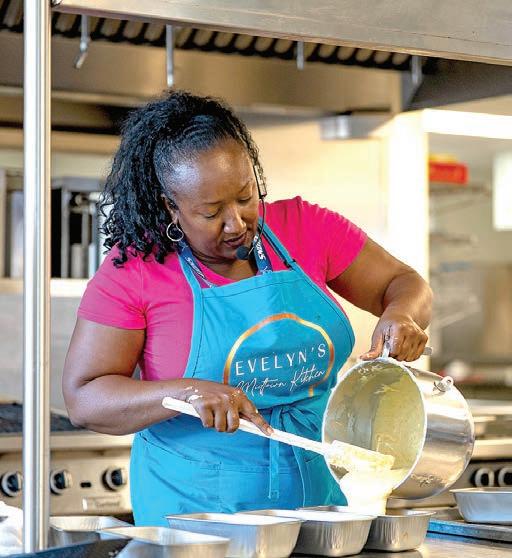
DETROIT – For so many, it is a beautiful honor to be able to fulfill the legacy of a parent or loved one.
For Belinda Beard, her business “The Egg Roll Diva” is a dedication to her mother, Cynthia Bell, who crafted unique egg roll recipes in the late 1980s—far before today’s egg roll “craze.”
“She was really into culinary, different cuisines,” Beard explains about her mom. “So, she just would try different foods and different cultures all the time and get us involved. We loved everything she made.
“Egg rolls became one of her staple dishes, with the favorite being one made with ground turkey. The way she made it was just so different from what we were used to. Once we knew it was a hit, we were kids, but we knew because all her friends, family, and neighbors just kept asking for these eggrolls. So, it became like a family thing.”
on numerous restaurant menus—corned beef egg rolls, in particular.
“I think I noticed it during the pandemic,” Beard said. “I’ve been making it my whole life. Then I looked around, and everybody had an egg roll on their menu. I was like, ‘Are you kidding me?’ Beard notes that there are a few things that differentiate her egg rolls from competitors.

“First of all, they’re made with love,” she says. And adds, “I always try to change up my flavor profile. I was doing the peach cobbler egg roll before I knew too many other people were doing it. Additionally, we are always coming up with new flavors and varieties. Also, our egg rolls are much larger than what you would find elsewhere in the city. They aren’t an appetizer size; they are more like an entree size. They’re filling, flavorful, and fresh.”
Belinda’s mom, who passed away in 1999, became known as “The Egg Roll Lady,” and in honoring her legacy, Belinda, as the eldest daughter, became “The Egg Roll Diva.” In recent years, egg rolls have become a staple


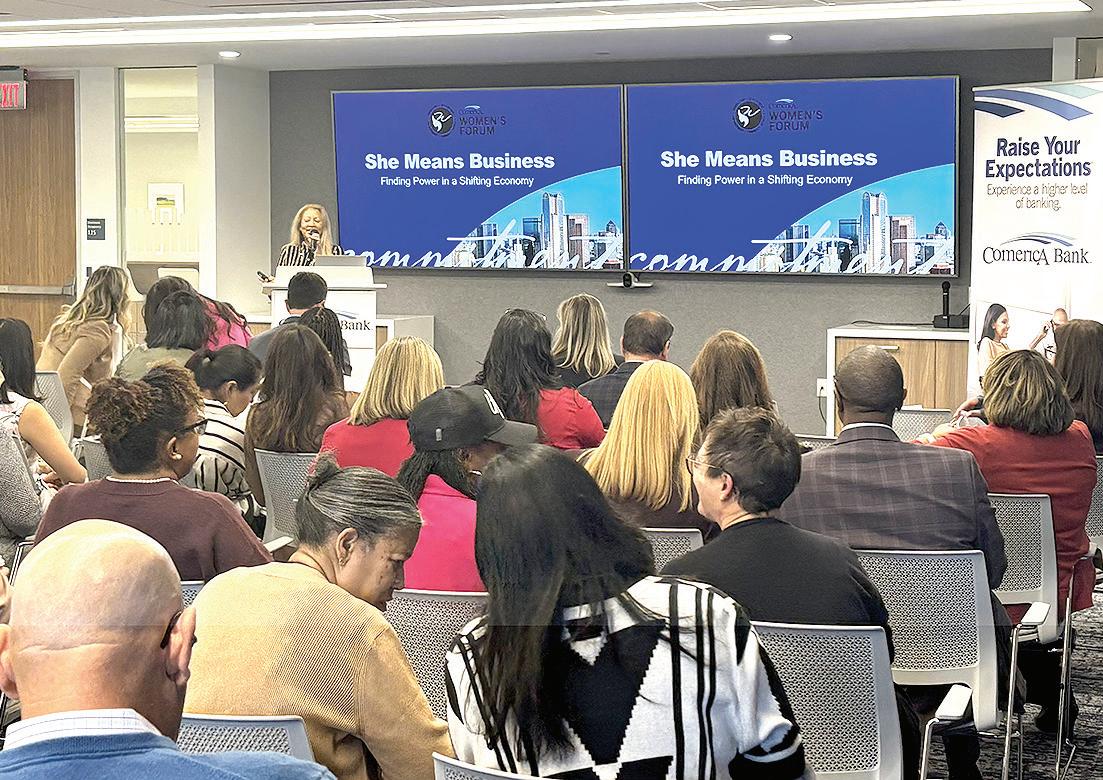
Comerica Bank is celebrating the builders, growers and barrier-breakers who are shaping what’s next this National Women’s Small Business Month by contributing $150,000 to organizations across its geographical footprint that provide technical assistance and micro-lending to female entrepreneurs. October’s contributions will bring this year’s total to over $300,000 to support women in business.
Additionally, Comerica will host a variety of local events across its markets to engage with female entrepreneurs in honor of Women’s Small Business Month.
and small businesses throughout the state.
GROW (formerly Grand Rapids Opportunities for Women) and T. Rose Foundation were honored for their contributions and commitment to supporting and cultivating women-owned businesses throughout the state.

“Women-owned small businesses play a vital role in our economy, and it is a privilege and a continued promise to support them in our local communities every day,” said Wendy Bridges, Comerica Bank Executive Vice President and Executive Director of Corporate Affairs.
“Community organizations are powerful resources for spurring women’s small business growth because they recognize the opportunities to make a real impact on their future.”
Exploring the state of women-owned small businesses
Today, there are more than 12 million women-owned small businesses nationwide. According to the first edition of the Comerica Small Business Pulse Index™, female business owners report a high level of confidence in the future success of their business and a moderate degree of optimism in the market conditions.
The national survey of 1,010 small business owners, conducted August 1-13, 2025, delves into small businesses’ confidence level, market outlook, AI adoption and more. Key insights from the 444 female small business owners who participated in the Index include:
Confidence Remains Strong: 81% of female small business owners say they are somewhat or very confident about the future success of their business.
Inflation Tops the List of Concerns: 23% of female small business owners report inflation is their number one issue of concern – the same level as the all-business owner average – followed by tariffs and cash flow challenges.
• AI Adoption Is Accelerating: 46% of surveyed female owners report using AI tools today, with another 30% reporting they plan to adopt AI within the next 12 months.
• Investing in AI: 74% of female business owners report spending up to 5% of their annual budget on AI tools, technologies and platforms.
• AI Job Displacement: Only 36% of all female business owners surveyed predict AI will replace jobs in their industry in the next 5 years. This is identical to the all-business owner level of sentiment.
• Government Oversight of AI: 53% of female business owners surveyed support stricter government regulations on AI for business use. This is marginally lower than 57% of male owners who believe the same.
“The vast majority of women small business owners surveyed expressed a confident business outlook,” said Larry Franco, Comerica Bank Executive Vice President and National Director of
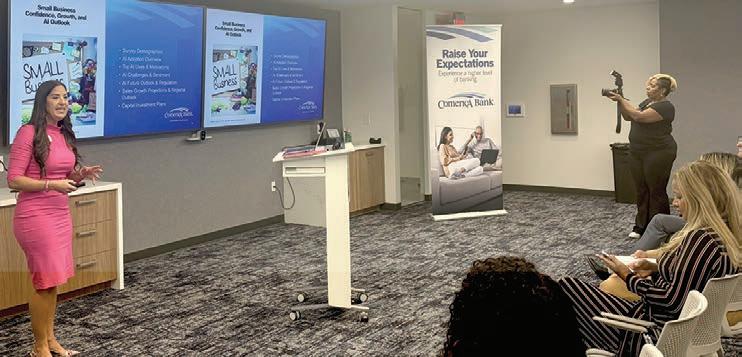
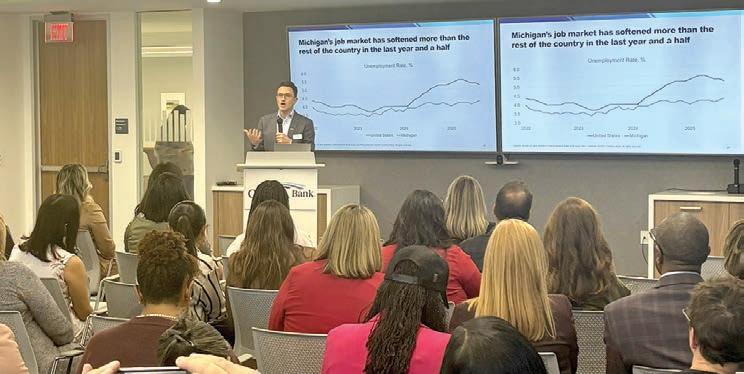
Retail & Small Business Banking. “This survey gives us a valuable glimpse into the state of women’s small businesses today.”
Swinging big for small businesses in 2025 Comerica’s contributions for Women’s Small Business Month quickly follow its week-long Small Business Week celebrations in May featuring customer and community-focused activities. The bank contributed $250,000 to five community organizations in Comerica markets focused on entrepreneurial development, growth, education and empowerment. Each nonprofit organization was additionally honored as a special guest during a check presentation at Comerica baseball-themed small business events in Detroit, Dallas, Houston, Los Angeles and San Francisco.
Comerica has prioritized bolstering its commitment to small businesses and entrepreneurs as well as supporting small business growth in the communities it serves over the past few years.
By establishing dedicated small business banking teams across its markets and creating several innovative initiatives and services, Comerica aims to simultaneously elevate customer experiences and positively impact the community.
“From contributions to community organizations to creating unique resources and solutions for small business customers, we’re committed to going above and beyond to provide real value to entrepreneurs and small business owners across
From page A-3
to open up their brick-and-mortar storefront in Detroit, Hamtramck, or Highland Park.
Stokes says that participating in Hatch was an “extraordinary” experience.
“You know, it’s always good to develop your chops and define who you are, and really go on a hardcore journey of promoting your business,” said Stokes.
“It was an incredible amount of work, but it was really great to connect with people at those events. The exposure is fantastic, and you also get a little bit deeper into the ecosystem, developing relationships within the extraordinary business ecosystem we have in Detroit.”
Known as Chef Evelyn, Stokes has a bachelor’s degree in political science and history from the University of Michigan, a master’s degree in business administration from the University of Phoenix, and an associate’s degree in culinary arts from the prestigious Schoolcraft College of Culinary Arts in Livonia.
Under the tutelage of several certified master and executive chefs, Stokes was formally trained in French culinary cuisine.
Stokes culinary journey has taken her to several places across Michigan, as well as to one of the finest French restaurants on the East Coast—Bar Boulud in New York—where she gained experience in a traditional French kitchen.
Her inspiration started out at home from her father and mother, David and June Stokes.
“My father was a cook in our family,” Stokes explains. “I was raised by entrepreneurs on the west side of Detroit, awesome people who got here at the tail end of the Great Migration and came to Detroit for new opportunity. My mother had opened a flower shop on the west side, and my father was a real estate agent. So, I was raised by these two people who had a lot of agency in their lives.
“They were pillars of the community. People looked up to them. They provided these safe spaces, and one way our family often connected,
our footprint,” said Jim Weber, Comerica Bank Executive Vice President and Chief Experience Officer.
About the Survey: The Comerica Small Business Pulse Index™ surveyed 1,010 small business owners across the U.S. between August 1-13, 2025. The survey has a margin of error of ±3.1% at a 95% confidence level.
She Means Business
On October 9, the Comerica Women’s Forum Impact team hosted small business clients, prospects and guests at the bank’s Great Lakes Campus for a networking event, She Means Business: Finding Power in a Shifting Economy, which presented economic insights and an overview of the bank’s recent small business survey on artificial intelligence.
Comerica’s Senior Vice President and Michigan Director of Small Business Meghan Storey reviewed the survey on AI and discussed topics pertaining to demographics, AI adoption and overview, top AI uses and motivations, AI challenges and sentiment, AI future outlook and regulation, sales growth projections and regional outlook, and capital investment plans.
Bill Adams, Comerica’s Chief Economist, also delivered an economic forecast for the months and year ahead.
Comerica also took the opportunity to recognize two long-time community partners who are impacting the growth of women’s entrepreneurs
GROW (growbusiness.org), led by Chief Executive Officer Milinda Ysasi, supports the economic development activities in the community by providing training, counseling, and mentoring programs to attract new industry and encourage the development of business and other community resources. GROW provides loans and financial assistance to promote community development and combat community deterioration and economic blight.
“We’re honored to celebrate one of our strongest community partners, GROW — led by the incredible Milinda Ysasi since April 2021,” said Kevin Watkins, Vice President and External Affairs Market Manager. “Milinda currently serves on our Community Development Advisory Council, and under her leadership, GROW has truly lived up to its name, empowering entrepreneurs across West Michigan with accessible microloans and small business technical assistance.”
In 2022, GROW was selected to participate in the ASPEN Institute microloan accelerator program, helping them to increase their loan volume and create a more sustaining organization as a Community Development Financial Institution. In 2023, they deployed over $1 million in small business loans, which helped them be recognized as the Michigan Micro-Lender of the Year from the Small Business Administration in 2024. Comerica Vice President and Retail District Manager Karen Brittner currently serves on GROW’s board of directors and Senior Vice President and Retail Regional Director Debra Hanes is a past member of the board.
The T. Rose Foundation (t-rosefoundation. org) reaches youth, primarily girls, early in their social developmental years to promote positive self-esteem and self-image. The foundation, founded by Theresa Randleman, provides support in personal development through social etiquette, health and wellness, and life skills; advancing a sense of self-mastery while building a meaningful relationship with their personal and professional gifts and talents, embracing entrepreneurship and leadership as future leaders and courageous changemakers.
“Comerica understands that small businesses are the life’s blood of our economy,” said Mike Cheatham, Vice President and External Affairs Market Manager. “We partner with organizations like the T. Rose Foundation to help us provide the type of support small businesses need to be more financially successful.
Comerica recently sponsored and supported the T. Rose Foundation and the organization’s Girlprenuer Summit in Lansing this summer.
Additionally, Comerica will be partnering with Randleman and her foundation on an upcoming Women’s Business Spotlight Series in Jackson.
The first half of the evening will provide participating entrepreneurs with information designed to help them better navigate the challenges of running a business. During the second half of the series, a local small business owner will share their entrepreneurial journey.
The goal of the series is to educate and inspire, while also providing visibility to businesses in the community.
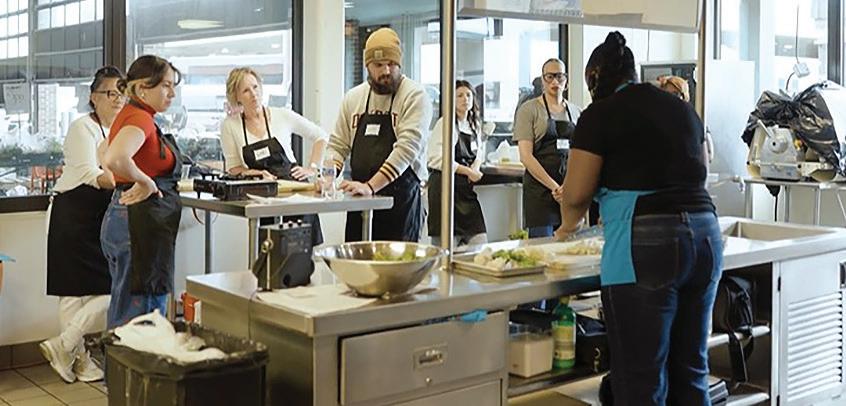
Evelyn’s Midtown Kitchen offers team-building corporate cooking classes, youth and family cooking sessions, wellness-focused workshops, and international cuisine experiences. For more information follow online at emkculinary.com and via social media on Instagram (@evelynsmidtownkitchen), Facebook: (@EMKCulinary),
whether it was during the holidays or throughout the year, was through food. And my father was extremely passionate about food. He planned our meals ahead. He really thought about interesting foods that we can eat for dinner. And I would help him a lot in the kitchen.” Stokes believes that food brings people together.
“It is what I promote,” said Stokes.
“My business is rooted in my own
background, where I believe food can bring people together, not just at the table, but in the kitchen as well. Kids learn something new. They feel good about themselves, you know, they’re confident in their ability to make something.”
Evelyn’s Midtown
experience. We enjoyed the meal we prepared in class, and we recreated the meal for Christmas Eve dinner for our family to rave reviews.”
Stokes loves when people come in and learning something new and have a great time. “Sometimes, on a Friday night,
A5 | October 15-21, 2025
By Dr. Anthony Kellum

Homeownership is the cornerstone of the American Dream a path to stability, independence, and generational wealth. Yet for the Black community, this dream has often been placed just out of reach, shaped by centuries of exclusionary policies, discriminatory practices, and systemic inequities. Understanding the connection between the racial wealth gap and homeownership disparities is essential to changing that narrative. Property, quite literally, is power and ownership remains one of the most effective tools for transforming economic outcomes within our community.
The Wealth Gap and Its Roots
The racial wealth gap in America didn’t happen by accident. It was built over generations through structural inequality from slavery and Jim Crow laws to redlining, predatory lending, and exclusion from federal housing programs that built the white middle class. In 2025, the typical white household holds nearly seven to ten times the wealth of a typical Black household. Much of this wealth difference can be traced directly to property ownership.
While white families were accumulating wealth through home equity appreciation, Black families were often renters paying into systems that never paid them back. Even today, homeownership rates for Black Americans remain around 44%, compared to 74% for white Americans, according to recent census data. That gap represents more than numbers it reflects lost opportunities for wealth accumulation, stability, and legacy building.
Why Homeownership Matters
Owning property doesn’t just provide a place to live it provides leverage. Homeownership allows families to build equity, borrow against that equity for education or entrepreneurship, and pass on financial strength to the next generation. It transforms neighborhoods, fosters civic pride, and anchors families in opportunity.
For Black communities, homeownership is about ownership of destiny a tangible way to participate in the wealth-building mechanisms of America. Every mortgage payment is an investment, every deed a declaration of independence from systems designed to keep us dependent.
Systemic Barriers That Persist
Despite progress, many barriers remain. Black homebuyers are still more likely to be denied mortgage loans, offered higher interest rates, or undervalued through biased appraisals. Appraisal discrimination alone can strip tens of thousands of dollars in value from Black-owned homes. Additionally, wage disparities, student loan debt, and lack of access to intergenerational wealth make saving for down payments more difficult.
But perhaps the most damaging barrier is psychological the persistent myth that homeownership is out of reach or too risky. This

By Ebony JJ Curry SENIOR REPORTER
Detroit Public Schools Community District has opened the Southeastern High School Career Technical Education Annex, the first completed new build under the district’s $700 million Facilities Master Plan. The new facility is a turning point for the East Side, marking renewed investment in both education and the neighborhood’s long-term stability.
The 11,000-square-foot annex includes a welding lab, a Computer Numerical Control (CNC) lab, and a collaborative learning space. Each is equipped with the same tools and machinery used in professional environments, ensuring that Detroit students train with the technology shaping today’s workforce. The $16 million project was delivered through the Facilities Master Plan, which aims to modernize Detroit’s public schools and expand access to career-based learning.
Superintendent Dr. Nikolai Vitti said the new building demonstrates that the district can make good on its commitments to families who have been waiting for meaningful change.
“We’re excited as a district. This is a long time coming,” Vitti said. “A lot of people are naturally skeptical about whether the district was going to deliver on some major facility projects, just because of the distrust that was created with emergency management and previous challenges with DPS. But it’s exciting that today we announced it was a ribbon cutting for a building that’s now complete — the Southeastern Annex, a $16 million investment.”
For Vitti, the project reflects a philosophy that rebuilding Detroit must begin where people live and learn.
“We were very intentional to do it here at Southeastern, one of our historic neighborhood high schools,” he said. “Southeastern was built in 1917. This was a very intentional investment in a neighborhood high school because we’re trying to rebuild our neighborhoods. We talk a lot in the city about how to rebuild. We talk about stadiums, and that’s all exciting. But in the end, we’re not going to rebuild a city if we’re not rebuilding neighborhoods. And you can’t rebuild neighborhoods if you’re not rebuilding schools.”
That connection between schools and neighborhoods defines Detroit’s story. Southeastern has been part of the East Side’s identity for generations, serving families whose roots stretch back to the city’s industrial boom. For residents, the new annex is evidence that public investment is reaching their side of town again. Many remember when vocational programs were eliminated, when buildings aged without repair, and when young people were forced to leave their neighborhoods to find opportunity.
Although that reality still remains true, the CTE Annex brings some change to that. Students can now enroll at Southeastern and gain access to advanced manufacturing and welding programs right in their community. It reduces travel barriers,

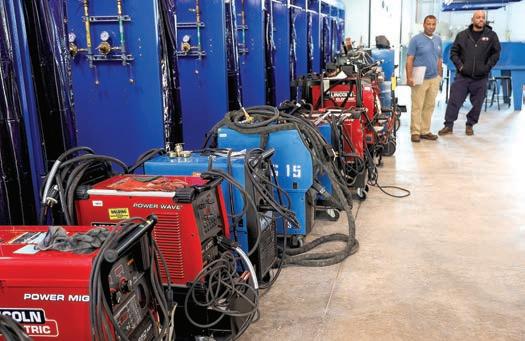
allows more consistent attendance, and gives young people a sense of pride in learning skills tied to Detroit’s economic DNA.
“We know that part of the identity, DNA of the city is manufacturing,” Vitti said. “And so this investment is about advanced manufacturing and welding. I’ve heard time and time again throughout the community, we need to bring back trades. So we’re doing that not in a separate building where students have to travel AM or PM to get to, but in a neighborhood high school. When students enroll here, they directly access that programming.”
For decades, the East Side has carried the weight of school closures and disinvestment. By selecting Southeastern as the first site for new construction under the Master Plan, the district is acknowledging that rebuilding trust starts with visible, local progress.
That progress extends beyond the school walls. For neighborhood parents, the new annex means their children can learn
By Ebony JJ Curry
SENIOR REPORTER
The power of Rosa Parks’ legacy has always rested in the quiet strength of her defiance and the lasting ripple of her belief that one act of courage can ignite generations. Forty-five years after she and Detroit partners founded the Rosa Parks Scholarship Foundation, that ripple is still transforming lives — one student, one scholarship, one dream at a time.

Since 1980, the foundation has awarded more than $3 million in scholarships to over 1,600 Michigan high school seniors. Each recipient carries a story of resilience, young people who refused to let financial barriers define their potential. In an era where college tuition has far outpaced inflation, these scholarships have been a lifeline, especially for students from Detroit and communities across the state where the cost of higher education can determine a family’s future.
The foundation’s president, Jim Rosenfeld, says this mission remains as urgent as ever. Each scholarship, he notes, celebrates not only academic excellence but the values Rosa Parks embodied: courage, leadership, and service.
“Funds raised at our upcoming event will help us continue our mission, supporting the next generation of scholars as they pursue their dreams in college and beyond,” he said.
That mission will take center stage on November 1, when the Rosa Parks Scholarship Foundation hosts its 45th Anniversary Gala at The Henry Ford Museum in Dearborn, fittingly, the same space that houses the historic Montgomery bus where Parks refused to give up her seat. The evening will honor her memory with stories, music, and community celebration. Detroit native and Emmy Award–winning actor Courtney B. Vance will serve as the keynote speaker, bringing home a message of perseverance and
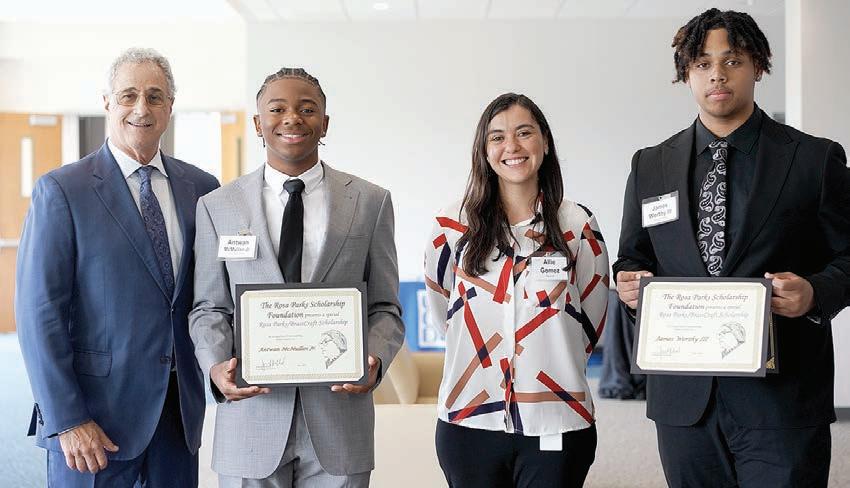
purpose that has defined both his career and the foundation’s ethos. The night will also feature remarks from Jamal Simmons, a CNN political commentator and creator of the TrailBlaze podcast, who returns as this year’s alumni speaker.
Guests will begin the evening with a VIP reception held in front of Rosa Parks’s restored bus — a national symbol of resistance now turned into a living classroom. The program will include dinner, dancing, and music from a Detroit DJ, all set against the backdrop of history that continues to move generations forward.
For alumna Monice Mitchell Simms, the scholarship was more than an award; it was a seed of
belief. Now an award-winning author, screenwriter, and producer, she remembers how receiving that scholarship shaped her confidence and ambition.
“Because of that, I got the confidence to apply for everything, and I kept applying and kept applying,” she recalled. “All because the Rosa Parks Scholarship Foundation — the same organization who honors one of my favorite heroes — saw me and let me know that I was worthy.”
That sense of being seen, valued, and believed in is what continues to distinguish the foundation’s work. Founded by Mrs. Parks alongside The Detroit News and Detroit Public Schools, the orga-
relevant, employable skills without leaving the community. It gives families who once felt left behind a reason to see the district differently.
Partnerships have also played a key role in ensuring the annex connects learning to real job pathways. Stellantis contributed $4 million to establish the annex and continues to work with Southeastern to align curriculum with industry needs.
“Stellantis is pleased to partner with Southeastern High School on the Career Technical Education Annex to create a pathway for students to pursue advanced manufacturing careers,” said Christine Estereicher, vice president of public affairs for Stellantis North America. “This investment will help boost enrollment and create opportunities for students for years to come.”
Those opportunities carry weight for students like Southeastern Senior Class President Aniya Ellis, who sees the new space as proof that the district believes in its youth.
“It means our school supporting the students with the best chance to succeed in life by supplying Welding and CNC Machining,” Ellis said. “I think it’s a great idea because it helps students experience, explore, and learn new skills to set them up for future success and careers. This building shows community through the hard work and commitment required to support the students at Southeastern High School.”
Her words capture the shift in student morale. Many Southeastern students have watched new developments rise downtown and in Midtown, but few have seen those
From page A-5 nization was built with the understanding that equity in education begins with access. Each scholarship awarded honors not only a student’s academic merit but also their commitment to community and their capacity to lead with purpose.
Erica Thedford, Rosa Parks’s great-niece and a member of the foundation’s board of directors, carries that family legacy into the next generation. She describes her aunt’s constant reminder that education was both a right and a responsibility, the foundation upon which every movement for progress must stand.

resources extend east. Now they are attending a school that feels modern, that reflects investment, and that offers a clear connection to Detroit’s job market.
Teachers report that hands-on programs like welding and machining often help reduce absenteeism because students feel their education has immediate value. When classes prepare them for real careers, attendance improves and graduation rates strengthen. That is one of the central goals of the district’s Master Plan — connecting engagement to relevance.
Southeastern’s enrollment has grown from 150 students in 2017 to 650 today, and district leaders expect continued growth as new programs attract families back to public education.
“We’re going to see Southeastern’s attendance continue to grow,” Vitti said. “And that’s only going to continue.”
The $700 million Facilities Master Plan is the most comprehensive reinvestment in Detroit’s school infrastructure in more than a generation. It addresses outdated systems, ensures ADA accessibility, and prioritizes new
“Auntie Rosa was always pushing us to make sure we went as far as we could with our education and never stopped learning,”
Thedford said. “That was the way to further everything — she was big on education and reaching back and pulling somebody up with you. It’s important to me to continue what she was doing with education, and I am proud to serve on the board of the scholarship foundation that bears her name.”
The impact of that message reverberates through every corner of Michigan. For countless recipients, the Rosa Parks Scholarship served as both a financial resource and a moral compass, reminding
construction in areas with the greatest need. The plan also reflects a shift in how DPSCD defines success: not only through test scores but through the ability to prepare students for life after graduation.
“At the end of the day, we’re just excited to be able to deliver this on time, within budget, at a neighborhood high school, on the East Side, which is also very intentional because we don’t have a lot of programming on the East Side,” Vitti said. “This is a great example of investing in our youth, in our neighborhoods, in our community. Long term, we’re going to see students more prepared for college and the world of work in particular.”
It also gives young people a reason to remain in their city — not out of necessity, but because opportunity exists where they are.
Across Detroit, similar facility upgrades will follow, but Southeastern now serves as a model for what meaningful investment looks like when it begins with listening. The voices of parents, students, and longtime residents shaped this plan. The building’s completion is proof that those voices mattered.
them that their journey toward higher education is also a continuation of a much larger struggle for equality. The foundation’s alumni include educators, engineers, lawyers, artists, and community advocates who have returned to uplift the same neighborhoods that nurtured their early dreams.
Detroit’s educational landscape has changed dramatically since 1980, but the need for support remains constant. Rising tuition costs, limited access to financial aid, and systemic inequities continue to weigh heavily on first-generation and low-income students, many of them Black youth navigating barriers that mirror the injustices Parks spent her life challenging. The foundation’s longevity is proof that small, consistent acts of
From page A-5
mindset has been reinforced by generations of exclusion. Overcoming it requires both financial literacy and cultural reprogramming: shifting from seeing homeownership as optional to seeing it as essential.
Closing the Gap: Education, Financing, and Community Investment
To close the homeownership divide, we must first educate not just on credit scores or loan types, but on the power of property itself. Workshops, church partnerships, and community-based education initiatives can break down complex processes and replace fear with confidence.
Financing is the second pillar. Leveraging first-time homebuyer programs, FHA and VA loans, and down payment assistance programs can help bridge the gap between aspiration and achievement. Many states and cities now offer grants or forgivable loans for qualified buyers, and understanding these resources can make the difference between renting for another decade and owning now.
Finally, community investment is key. When we buy in our neighborhoods, we build power where we live. Local ownership supports small businesses, attracts services, and raises
community investment can spark transformative change.
At the Henry Ford Museum, where history meets reflection, this anniversary will not simply mark the passage of time but the endurance of an idea. Rosa Parks’ commitment to justice was rooted in quiet but unshakable conviction; that standing still in courage could move a nation forward. The students who receive these scholarships embody that same spirit.
As the foundation looks to the future, its leaders envision expanding outreach, increasing scholarship amounts, and ensuring that every deserving Michigan student, regardless of background, has a fair shot at success. The 45th anniversary is a moment to cele-
property values in ways that benefit residents, not outsiders.
Practical Tips for Building Wealth Through Homeownership
Credit Building:
Monitor your credit report regularly and address errors promptly. Pay down revolving debt to keep credit utilization below 30%.
Leverage Programs: Research local and national first-time buyer programs that offer low down payments, reduced rates, or close-cost assistance.
Understand Equity Growth: Homeownership is a longterm wealth strategy. Even modest appreciation, combined with principal reduction, can build substantial equity over time.
A Call to Action
Property is not just land its leverage, legacy, and liberation. Closing the homeownership divide requires more than policy change; it demands a collective shift in mindset. When Black ownership rises, Black wealth rises. And when Black wealth rises, our communities gain strength.
Property is Power! is a movement to promote home and community ownership. Studies indicate homeownership leads to higher graduation rates, family wealth, and community involvement.
brate how far they’ve come and to recommit to the generations yet to rise.
The Rosa Parks Scholarship Foundation’s legacy endures in the faces of young scholars who carry forward her belief in education as a tool of liberation. And in Detroit her story remains alive, not just in museums or textbooks, but in classrooms, on campuses, and within every student who dares to dream boldly, knowing that someone once sat down so they could stand tall.
Tickets for the 45th Anniversary Gala can be purchased through Eventbrite. More information about the Rosa Parks Scholarship Foundation and its scholarship opportunities is available at rosaparksscholarship.org.


By Samuel Robinson SENIOR REPORTER
The Michigan Democratic Party purchased several billboards across Detroit criticizing the city’s mayor, Mike Duggan, for accepting donations from longtime Republican allies for his independent bid for governor.
Duggan announced he left the party last year in December upon revealing that he would run for governor after serving as mayor for 12 years.
The Michigan Democratic Party purchased several billboards across Detroit criticizing the city’s mayor, Mike Duggan, for accepting donations from longtime Republican allies during his independent bid for governor.
Duggan announced he left the party last year in December upon revealing that he would run for governor after serving as mayor for 12 years.
The Michigan Democratic Party today launched new billboards across Detroit highlighting the major
support that Mike Duggan’s campaign has received from prominent MAGA megadonors and Trump loyalists.
As Duggan’s ties to Republican donors are scrutinized by Democrats, one Republican state party official, Chris Long, told the Midwesterner, a conservative news website earlier this year that he feared Duggan’s campaign could hurt the party’s candidates.
The party said it purchased the billboards to run the same day as Duggan attended a fundraiser tonight in Detroit with a Trump donor.
“The billboards are part of MDP’s efforts to hold Duggan accountable and show Michiganders that he can’t be trusted,” MDP spokesperson Derrick Honeyman said in a release. Duggan’s campaign finance records show donations from an array of business leaders and executives who have backed both Republicans and Democrats. Duggan’s critics point to
By Michigan Chronicle Editorial Board
The Michigan Chronicle, Detroit’s longstanding voice of the community, is increasing its price for the first time in nearly two decades. Starting next month on Nov. 5, 2025, the cost of a single issue will rise from $1 to $2. This change comes as part of an industry-wide shift in response to the evolving media landscape, while maintaining our commitment to providing quality journalism to our readers.
Since our founding, the Michigan Chronicle has remained dedicated to serving the Detroit community with accurate, insightful, and relevant news. Over the years, we’ve worked tirelessly to keep our prices affordable for all readers, even as operating costs have steadily increased. In fact, the last time our price was adjusted was nearly 20 years ago. As the cost of printing, distribution, and news gathering continues to rise, this modest price increase ensures that we can continue to invest in high-quality journalism without sacrificing the integrity of our content.
Despite the price adjustment, the Michigan Chronicle remains one of the most affordable publications in the area. We recognize that many of our readers rely on us for news that speaks directly to their lives, their community, and their concerns. Our goal is to ensure that price does not become a barrier to access, and we believe this modest increase is a necessary step to continue providing the high standards our readers expect.
We’re also proud to offer free and accessible content online. While print prices are adjusting, our digital presence remains entirely free of charge, ensuring that anyone with internet access can stay informed on local and national news without any added cost. Our website and social media channels remain vital parts of our mission to make news available to as many people as possible.
This price change is part of a broader transformation within the media industry, as traditional print journalism adapts to new economic realities. The Michigan Chronicle will continue to evolve with these changes, but our commitment to serving our community remains the same. We thank our loyal readers for their ongoing support and look forward to continuing to inform and inspire our city for years to come.


By Rev. Dr. Wendell Anthony CONTRIBUTING COLUMNIST
As we march closer towards authoritarianism in our nation, we are reminded of the words of Frederick Douglass, “The limits of tyrants are prescribed by the endurance of those they oppress.”
In March of 2025, America, for the first time in 249 years, since the founding of our nation, was placed on an international human rights watch list. The Civicus Monitor, a research tool that publicizes the status of freedoms and threats to civil liberties worldwide, placed the United States on a list with Turkey, El Salvador, Siberia, Kenya, Pakistan, Indonesia, and several others.
his stand against such actions. Following the January 6 attack upon the nation’s capital, General Milley called his Chinese counterparts to reassure them that the United States was not under threat of an attack. President Trump said, “This is an act so egregious that in times gone by, the punishment would have been death.” General Milley reminds the nation, “We don’t take an oath to a King or a Queen or to a tyrant or dictator. And we don’t take an oath to a wannabe dictator. We don’t take an oath to an individual. We take an oath to the constitution, and we take an oath to the idea that is America, and we are willing to die to protect it.”

donations from charter school advocate J.C. Huizenga, former Michigan GOP Ron Weiser and former cochair Jeff Sakwa.
Duggan has been endorsed by a number of labor groups who typically support Democrats, including Unite Here Local 24, Michigan Council of Regional Carpenters and Millwrights, Detroit Plumbers Local 98, Detroit Firefighters Association Local 344, the Detroit Stage Employees Union and IBEW Local 58.
The mayor of Michigan’s largest city is also endorsed by Detroit Branch NAACP president Rev. Wendell Anthony, who has supported Democrats until Duggan’s independent campaign.
“At least the Michigan Democratic Party is predictable - they always think calling someone a Republican is the worst possible insult,” said Andrea Bitely, a spokesperson for Duggan’s campaign. “Can’t wait to see their billboard insulting the 11 traditionally Democratic unions who have already endorsed Mayor Duggan for governor.”
Secretary of State Jocelyn Benson, Genesee County Sheriff Chris Swanson and Lt. Gov. Garlin Gilchrist are running for governor as Democrats.
2018 attorney general candidate Tom Leonard, Senate Minority Leader Aric Nesbitt and U.S. Rep. John James are running for governor as Republicans.
You can reach Sam at srobinson@michronicle.com.
This global alliance and network of civil society groups also includes Amnesty International. The list was reaffirmed in July of this year. According to Mandeep Tiwana, Civicus’ Secretary General, “The United States appears to be sliding deeper into the quicksand’s of authoritarianism. Peaceful protests are confronted with military force. Critics are treated as criminals. Journalists are targeted and support for civil society and international cooperation has been cut back.”
This penetration into the depths of an American autocracy can be seen and heard as both President Trump and his man-atarms Stephen Miller continue to hint at the implementation of the Insurrection Act of 1807. The main purpose and provision of the act, “Empowers the U.S. President to deploy military forces and federalize the National Guard during certain emergencies within the United States.” It basically allows the President to declare Martial Law.
These days it seems that everything is an emergency. The implementation of tariffs on products from automobile parts to pharmaceuticals for the heart is an emergency. Shutting down government institutions, Department of Education, USAID, eliminating hundreds of thousands of federal workers (straight out of the notorious Project 2025), all seem to be an emergency.
It is exacerbated by forcing the Department of Justice to seek retribution by going after those on the President’s enemies list. Among them, Letitia James in New York; Fani Willis in Atlanta; James Comey, Former FBI Director; Senator Adam Schiff for his January 6 investigation of attacks on the nation’s capital; Lisa Cook, Member of the Federal Reserve; and Jerome Powell, Chairman of the Federal Reserve. Sending the military into Chicago (using Black Hawk helicopters over an apartment building), Memphis, Los Angeles, Washington D.C., and threatening Portland and others with emergencies provides a justification for the President and Stephen Miller to send in the troops declaring a phony insurrection. State and local officials have said they do not want them, nor have they requested them.
General Mark Milley, former Chairman of the Joint Chiefs of Staff, was threatened with execution as a result of
Members of Congress, whether Republican or Democrat, who enable the President to break laws and ignore the constitution need to remember their oath, “I do solemnly swear (or affirm) that I will support and defend the constitution of the United States against all enemies, foreign and domestic, and that I will bear true faith and allegiance to the same. That I take this obligation freely without any mental reservation or purpose of evasion and that I will well and faithfully discharge the duties of the office on which I am about to enter, so help me God.” While many have forgotten or ignored their oath to the people, they have willingly surrendered it to a President.
If America is to survive this hour it will take people from all walks of life – every race, every community, both male and female. Many will have to move beyond personal ideology to a more noble causality. It does not matter your party affiliation or faith. It must be about people coming together in unity from every vocation. Many are still upset and angry about the last election and how the nation got here.
We know who voted and who did not. We know who told others to stay home and to cast their vote for the man that currently occupies the White House. For those who say I told you so, okay, we get it. However that position still leaves us divided, angry, and unproductive. The cause is too great and the consequences for such a position is too dangerous.
Everyone is needed for this peaceful battle to reclaim the soul of our nation. Faith leaders must preach about it. Artists must sing, write, and speak for it. Teachers must instruct on the importance of it. Civil rights organizations must continue to organize, speaking boldly and loudly against it. Politicians must do their jobs and enforce legislation to redirect it. Universities and law firms must unite to stand firmly against it. Business, corporate, and labor leaders must support and caucus together, and use their resources to help support this cause.
In the end, if we stick together, we will get the victory because we as the people of America demand it. Rev. Dr. Martin Luther King, Jr., said, “We didn’t all come over here on the same ship, but we are all in the same ship now.” Let us sail on until we reach that beautiful shore of dignity, respect and freedom to preserve our democracy. Only the people can save America from itself.


Comerica Bank annually supports the American Cancer Society’s Making Strides Against Breast Cancer, “the nation’s largest and most impactful breast cancer movement working tirelessly to end breast cancer as we know it,” according to the ACS.
Making Strides of Detroit, which draws thousands of participants, was held Saturday, Oct. 11 at the Historic Corner Ballpark (former Tiger Stadium) in the Corktown
“I
The


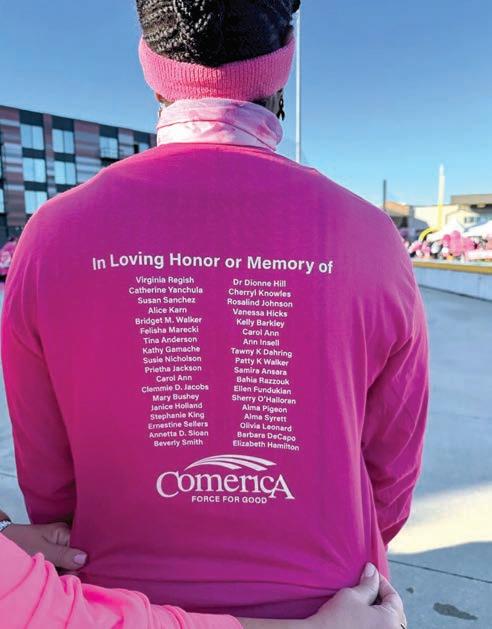
ry of Small Business and Entrepreneurship. Award winners are highlighted for uplifting communities through innovation, job creation, and local ownership. Comerica’s partnership with TechTown Detroit and Comerica’s support of Hatch Detroit played a key role in the recognition.
Each year, MMSDC recognizes individuals, businesses, and organizations throughout the state to celebrate those whose work consistently strengthens neighborhoods, opens doors, and uplifts lives across Michigan.
MMSDC’s ACE Awards returned on Oct. 7 with an evening themed “Woven With Purpose,” at the Suburban Collection Showplace in Novi. The ACE Awards honorees embody the spirit of innovation, growth, and community impact that defines the MMSDC’s mission and constituents across Michigan.
This year, Comerica Bank was recognized as a 2025 Community Impact Honorees in the catego-
“Congratulations to the Comerica External Affairs and Small Business Banking teams for Comerica’s recognition in the category of ‘Small Business and Entrepreneurship’ at this year’s MMSDC ACE Awards focused on Community Impact,” said Teresa LeFevre, Comerica Bank Vice President and Supplier Engagement Manager.
The evening celebrating changemakers was an extraordinary event featuring immersive storytelling, music, food, fun, and purpose-filled connections.
“It was a fantastic evening celebrating the champions of change and the inspiring stories that connect us all. Together, we can continue to strengthen our communities and create a brighter future for everyone,” said Yolanda Serra, Comerica Bank Vice President and Small Business Banking Group Manager.
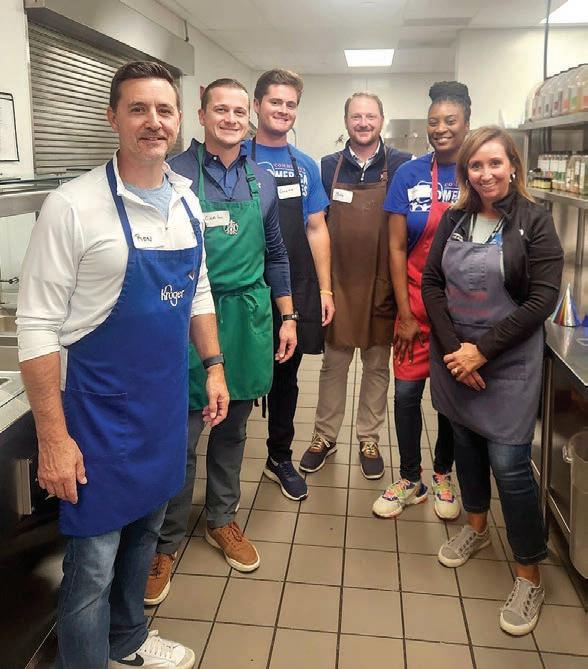
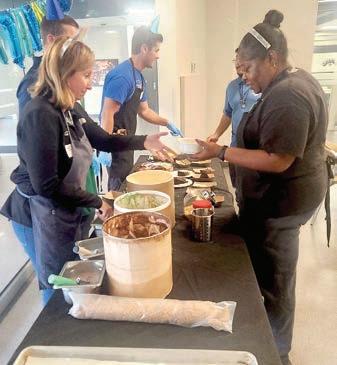
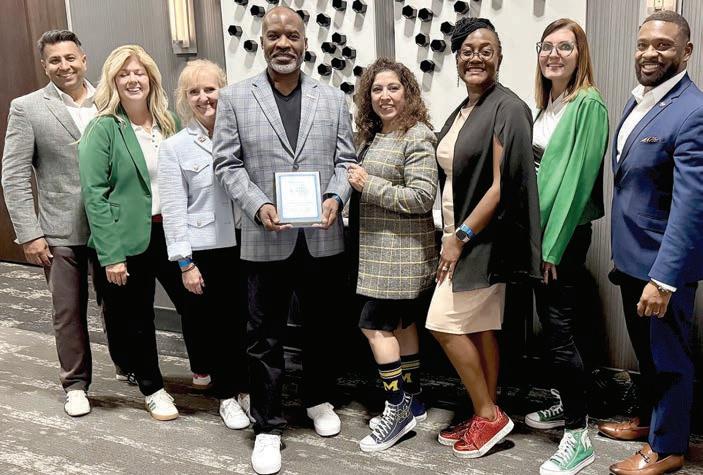
mentors who provided professional services and expert advice to help the contestants create viable business plans and craft a compelling business pitch.
Beard had the good fortune of being mentored by Steve Davis, Michigan Market President of Comerica Bank.
“Belinda is truly inspiring,” said Davis. “Getting to know her and mentoring her through Michigan Women Forward was an honor, and I was impressed to see where she is on her journey. She is committed to both the day-to-day operations of her business but also to the learning process that it takes to be a successful business owner.”
“Egg Roll Diva is a passion of hers and you can see that passion showing though her dedication and hard work. I can’t wait to see what is on the horizon for her. The future is very bright for Belinda and Egg Roll Diva.”
“Inspiring” is also the word that Beard uses to describe being mentored by Davis. She says, “I had the perfect mentor for the competition. I really feel like he really helped me.”
Finalists in the statewide food competition pre-record their pitches and prepare samples of their food they serve at an in-person event attended by guests, food industry leaders/investors and our panel of judges.
In the end, Beard and Egg Roll Diva was a winner and claimed one of Michigan Women Forward’s $10,000 grand prizes.
“With all of the preparation I had with my mentor, by the time it was down to the competition, I felt so, so secure. I thought, ‘I got this.’ So, it just felt so good when I actually won. It was all worth it,” said Beard.
“Belinda stood out because she’s the perfect blend of passion,

perseverance, and purpose,” says Carolyn Cassin, CEO of Michigan Women Forward. Cassin adds, “From the moment she pitched, you could see her vision so clearly — she wasn’t just selling egg rolls. She was creating a business rooted in culture, flavor, and community. She understood her numbers, she knew her audience, and she had that spark — the drive to keep going no matter what. That combination of heart and business acumen is exactly what we look for in a WomanUp &Pitch winner.”
Beard is continuing the legacy and love that egg rolls represent for her family. She has a rotating staff of eight to 10 employees—most of whom are family including her brother and several nieces.
“My whole family has jumped in because they saw the success of Egg Roll Diva, and they believe in the mission and the vision,” said Beard.
To check out and see what Egg Roll Diva is all about, visit Beard’s food truck, catering, and cooking classes upcoming schedule at EggRollDiva.com. She can also be found
on Instagram (@eggrolldiva), Facebook (@EggRollDiva) and YouTube (@eggrolldiva).
Michigan Women Forward Founded in 1986, Michigan Women Forward is a nonprofit organization
B1 | October 15-21, 2025
By Jeremy Allen
EXECUTIVE EDITOR
Detroit celebrated a new chapter this week in its efforts to revitalize and reconnect its neighborhoods, as Leona Medley, executive director of the Joe Louis Greenway Partnership, and Detroit Mayor Mike Duggan joined residents and community partners to officially open a newly completed stretch of the Joe Louis Greenway near Grand River and Oakman Boulevard.
The event also marked the unveiling of a striking new bronze statue honoring legendary boxer Joe Louis, not for his accomplishments in the ring, but for his often-overlooked role in breaking racial barriers in professional golf.
The recently completed section of the Joe Louis Greenway adds two miles of pedestrian and bike-friendly path between Joy Road and Intervale Street. This expansion builds on the section opened in 2023 that runs from Warren Avenue to Joy Road. With this addition, the total length of completed greenway now approaches six miles, and another six miles are expected to be completed by the end of 2026. The greenway, when finished, will stretch 29 miles through Detroit and into neighboring communities including Highland Park, Hamtramck, and Dearborn, connecting 23 Detroit neighborhoods along the way. Duggan, speaking at the ribbon-cutting, emphasized the impact the greenway is already having on Detroit’s landscape and sense of community.
“The Joe Louis Greenway is transforming miles of blight and creating beauty and recreational opportunities, while connecting neighborhoods in a new way,” he said. “We named the greenway after Joe Louis because of his incredible contributions in and outside of the ring, and I’m thrilled to be here with his daughter, Joyce, to unveil the beautiful new statue of her father.”
The latest segment includes new sidewalks and bike paths, but also important safety and aesthetic features such as steel panel fencing, landscaping with new trees, lighting, and emergency call boxes. A key addition is a new trailhead located at Grand River Avenue near Cloverdale Street. This trailhead features an open-air shelter available for reservation and gatherings, a resurfaced alley to support food trucks and entertainment, and a public plaza that now serves as home to the new Joe Louis statue. Designed to be a welcoming gateway into the greenway, it mirrors the functionality of the already existing trailhead at West Warren Avenue.
The newly unveiled statue, titled “Outside the Ring,” was created by Detroit-based artist Austen Brantley. Cast in bronze, the sculpture pays tribute to Joe Louis’ groundbreaking influence on the game of golf. Known to most for his dominance in boxing,
See JOE LOUIS STATUE Page B-2

By Ebony JJ Curry SENIOR REPORTER
Detroit will introduce a new, city-built contemporary art platform with global partners and a long runway for local artists. Detroit Salon, created by Detroit-based Salonnière and backed by the State of Michigan, Visit Detroit, CultureSource and others, will debut internationally in Paris in fall 2025, open a community-driven artist call in January 2026, and stage a full citywide edition in Detroit in 2028. The headquarters will be the Detroit Salon Art House in Paradise Valley, where year-round exhibitions, salons and artist development are planned. After 2028, the fair is intended to recur every two years.
The initiative enters a city with a deep and resilient visual arts tradition. Detroit’s art history runs from the Detroit Institute of Arts’ Rivera Court murals — Diego Rivera’s 1930s homage to the city’s industrial workers — to the 1980s rise of Tyree Guyton’s Heidelberg Project on the East Side and Olayami Dabls’ African Bead Museum on the West. The city’s designation as the only U.S. UNESCO City of Design underscores that creative lineage. Today, artists such as Tiff Massey, Sheefy McFly, Darius Baber, Sydney G. James, and Oshun Williams are pushing Detroit’s visual identity forward from massive public murals and sculpture to digital installations and fashion design — making the city’s scene one of the most robust in the country.

Organizers describe Detroit Salon as both a global exhibitions platform and a Detroit-rooted infrastructure play. Partnerships include Art Basel and 1-54 Contemporary African Art Fair. The plan is to connect Detroit artists to audiences in Paris, Basel and London while building a home base that elevates neighborhood voices and institu-
tions across the city.
“The first thing for us is relationships,” said Artistic Director and Chief Curator Juana Williams, a Detroiter whose career has focused on connecting artists and audiences. “We are taking artists into interna-
By Jeremy Allen
EXECUTIVE EDITOR

As the lights dim and the music swells on Nov. 7, the glitz and glamour of a blacktie gala will fill the ballroom at The Henry in Dearborn. But for Lenora Hardy-Foster, President and CEO of Judson Center, the evening will be more than just an elegant affair of food, fun, and entertainment. It will be a celebration of a commitment lasting more than a century long to serving Michigan’s most vulnerable families, children, and individuals.
This year marks 101 years since Judson Center opened its doors in Royal Oak. What began as a small, local organization focused on foster care and adoption has evolved into one of Michigan’s most comprehensive providers of social services. And Hardy-Foster, who’s preparing to celebrate her 10th anniversary at the helm, has played a pivotal role in steering the organization toward new heights.
“I can’t believe it’s been nearly a decade,” Hardy-Foster said, reflecting on her time with the center. “When I started, we had

this singular focus on adoption and foster care, but today we’re reaching so many more people in so many different ways. It’s been such an incredible journey.”
explained. “So we brought together behavioral health services with primary care, so people could get everything they needed in one place.”
This approach, which is rare in Michigan, has been a game-changer for many of Judson Center’s clients. Hardy-Foster shared a powerful example: “We had one client, a woman with severe mental health challenges, who had been diagnosed with diabetes. She wasn’t receiving the care she needed for her physical health, and it was only when we brought a primary care doctor into the picture that we were able to improve her condition. Her life expectancy is now much higher because she’s getting the care she deserves.”
Under Hardy-Foster’s leadership, Judson Center has grown its physical footprint as well. Offices in Flint, Ann Arbor, and Dearborn have opened, making it easier for families to access services. In a state where access to care can be limited, especially in rural areas, these expansions have been vital.
One of her most transformative initiatives was the introduction of the integrated care model.
“What we realized over time is that our clients weren’t just struggling with one issue. They were dealing with multiple challenges that were often interconnected— mental health diagnoses, chronic medical conditions, substance use,” Hardy-Foster
Judson Center’s mission now spans a wide range of services: autism care, behavioral health, primary healthcare, substance use disorder treatment, and support for individuals with disabilities. Hardy-Foster has overseen this evolution with the clear vision to integrate wrap-around services in a way that addresses the full spectrum of her clients’ needs.
“We’re always asking ourselves, ‘What’s next?’” Hardy-Foster said, a tone of anticipation in her voice. “When I first came here, we had one autism program. Now, we have five locations across the state, and we’re continuing to grow.”
For her, it’s all about the impact. “I’m
tional rooms so they can build the networks that sustain careers. We are also curating with a Detroit committee and speaking directly with artists through an advisory group that started at 11 members and will keep growing.”
Williams said two of the Paris shows are being assembled through nominations from dozens of Michigan arts leaders and a juried review, while a third will be curated by her team. “There has always been a strong arts and culture scene here,” she said. “We talk a lot about music and design. Visual art needs to be part of that global conversation, and Detroit artists need the access that comes with it.”
CultureSource Executive Director Omari Rush, a community partner for the initiative, framed the timing as alignment with Detroit’s longstanding creative engine. “Detroit has started industrial, social, artistic and labor movements from the ground up,” Rush said. “This gives visibility to that characteristic and more air to the work happening at smaller scales alongside major institutions.” He added that he hopes the experience accelerates artists’ momentum and business capacity. “As artists interact with new audiences and buyers, it helps them calibrate as entrepreneurs, how they present, price and position their work.”
Visit Detroit President and CEO Claude Molinari said the effort meets a tourism and jobs mandate as well as a cultural one. “Detroit is known for cars, culture, music and design. We are not yet on the map for our art scene the way we should be,” Molinari said. “Detroit Salon is a platform to elevate the city on a world stage. If it is successful and we intend it to be, the world will take notice. That means visitors in hotels, people in restaurants and attractions, and well-paying jobs for Southeast Michigan residents who work the event.”
Founder Julie Egan said the team pursued lengthy negotiations to ensure Detroit control across creative decisions and storytelling. “Our exhibitions are curated by a Detroit curator. Our selection and committee processes include curators and cultural workers from institutions across Michigan. And when our partners tell Detroit’s story across their channels, that work is done by Detroit or Michigan writers, photographers and videographers,” Egan said. “We wanted global reach without losing Detroit’s voice.”
Egan confirmed a three-year global partnership with Art Basel that places Detroit activations inside multiple fairs beginning in Paris. She also cited collaboration with 1-54, the leading fair for contemporary African art, and plans for an exhibition during the Venice Biennial period in 2028. “The
From page B-1
proud that we can meet people where they are—whether that’s in their community or through a statewide program like the Michigan Adoption Resource Exchange,” she added. The exchange connects older children in foster care with adoptive families, a critical service in a system where children over the age of 10 are often overlooked.
But even with all the progress, Hardy-Foster is quick to acknowledge that it’s not just about the numbers. It’s about the lives touched, the families changed, and the community strengthened. “When we moved our office, it wasn’t just about the space,” she explained. “It was about providing better services for families in the area, and giving our staff the tools and environment they need to succeed.”
Hardy-Foster’s proudest accomplishment, however, may be Judson Center’s recent achievement as a Certified Community Behavioral Health Clinic (CCBHC)—a distinction held by only a handful of organizations in Michigan. “It’s not easy to get certified, and it’s something that took years of hard work,” she said. “But it means we can serve more people and get the resources we need to make a greater impact.”
These milestones are proof that the work is making a difference. “We’re doing things that no one else is doing, and it’s changing lives every day,” she said.
And while Judson Center’s accomplishments are worth celebrating, the gala on Nov. 7 will also serve as a reminder of what’s yet to come. Hardy-Foster hopes that the event will raise money and awareness about the organization’s critical work.
“The gala is a chance to celebrate, but it’s also a chance to invite the community into our story,” she said. “We want people to
goal is clear,” she said. “We want our partners’ networks talking about Detroit while Detroit artists and institutions shape the narrative.”
The 2028 Detroit edition is planned as a citywide presentation that uses museums, galleries, neighborhoods and public spaces. Organizers said success will be measured by artist opportunities, institutional traffic and a durable pipeline for cultural tourism and investment. “We want people who may not have otherwise visited to come here for the visual arts,” Egan said. “We are creating a platform, but the point is to drive new audiences to our museums, our galleries, our studios and our collectors. A rising tide.”
For Detroit artists, Williams points to the practical benefits of traveling together and working across disciplines and generations. “Last year, when a small group went to Paris, the conversations we had as a cohort could not have happened at home. Working this way strengthens the ecosystem,” she said. “Artists will meet people they would not have met otherwise, learn from different audiences, and bring that learning back into their practice.”
Rush underscored Detroit’s standing among cultural capitals. “There are source communities where culture starts,” he said. “Detroit belongs alongside places like New Orleans and Paris because of the forms and styles that started here, Motown, techno, mid-century and automotive design. This initiative invites the rest of the world to engage with that reality.”
Molinari called the 2028 fair a validator for the region. “It says that beyond music, sports and mobility, this is also a place for contemporary art,” he said. “We believe once people come, perceptions change. And when perceptions change, investment follows.”
Key dates are set. The first international stop is Paris in fall 2025. The open call for artists begins January 2026. Detroit hosts the inaugural citywide edition in fall 2028. Between those markers, Detroit Salon plans exhibitions with its global partners and steady programming from Paradise Valley.
That neighborhood itself carries deep symbolism. Once the commercial and entertainment heart of Black Bottom, Paradise Valley was home to hundreds of Blackowned businesses and venues during segregation. Re-anchoring an international art house there ties the project directly to Detroit’s legacy of Black entrepreneurship and creative self-determination.
Egan summarized the longer horizon. “We are claiming our place on the global art world calendar in 2028 and every two years after,” she said. “The work between now and then is to keep doors open for Detroit artists, protect the integrity of Detroit storytelling, and invite the world to see what this community makes.”
see that this isn’t just about a fancy event; it’s about giving back to those who need it most.”
The evening will be a night of fashion, live entertainment, and dancing—an evening where the community can come together in support of the lives changed by Judson Center’s work. “It’s really a celebration of the people we serve, the staff who make it all happen, and the community that supports us,” Hardy-Foster said.
For those attending, the night will also hold a special moment of recognition. The Care of Art Award will be presented to an individual who has demonstrated outstanding support for Judson Center. The award, which recognizes both financial and handson contributions, will honor someone who has gone above and beyond in helping advance the organization’s mission. “We want to thank the people who have been with us every step of the way,” Hardy-Foster explained. “It’s their commitment that allows us to do the work we do.”
As Judson Center moves into its second century of service, Hardy-Foster is looking ahead with optimism. “We’ve accomplished so much, but the work is never done,” she said. “Every year, we ask ourselves, ‘How can we do more? How can we help more people?’ That’s what drives me, and that’s what keeps us moving forward.”
With a legacy of service that spans more than a century, Hardy-Foster is already looking toward the next 101 years, saying: “We’ll keep pushing forward, and we’ll keep making a difference.”
Tickets for the gala are available for $250 per person or $400 for couples, with sponsorship opportunities available for those who wish to make a larger impact. For more information and to purchase tickets, visit Judson Center’s website at https:// www.judsoncenter.org.

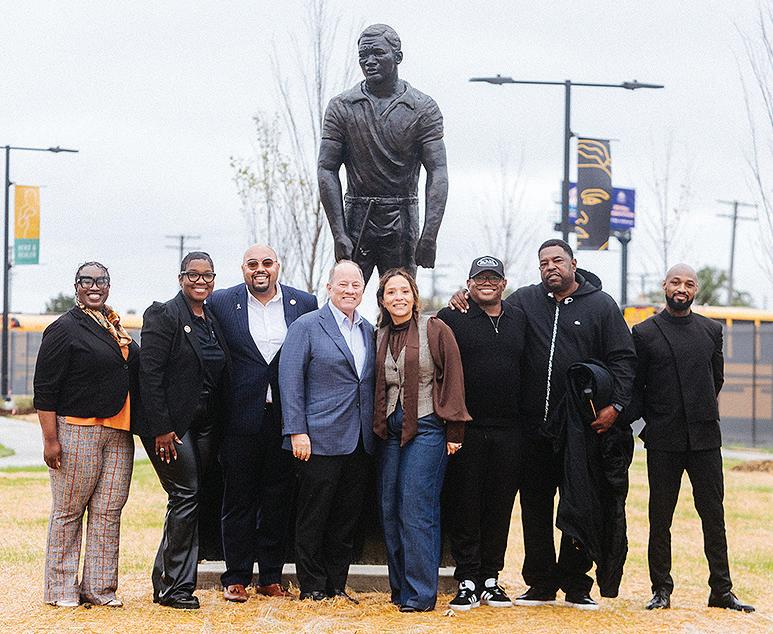
Louis was also the first African American to compete in a PGA-sanctioned tournament. Beyond his own personal achievements, he actively worked to open the sport to other Black athletes, most notably through the creation of the Joe Louis Open golf tournaments, which ran from 1941 to 1951 in Detroit and offered a platform for Black golfers who were barred from mainstream competition.
“The spirit that never quits—that’s what this statue means to me,” said Joyce Barrow-Henderson, Louis’ daughter, as she reflected on her father’s enduring legacy. “Not only for golfers, but for families, for children, for dreamers, for every person who knows that greatness does not come from winning every fight—it comes from getting back up again, again and again.”
Brantley, a self-taught figurative sculptor, completed the statue over the course of five months after being selected through an open call issued by the City of Detroit’s General Services Department in collaboration with the Office of Arts, Culture and Entrepreneurship (Detroit ACE).
A panel that included artists, architects, business leaders, and members of the Louis family chose Brantley for the commission. According to Rochelle Riley, Detroit’s Director of Arts and Culture, the statue was part of a larger mission to highlight Louis’ role as a pioneer who helped change the face of American sports. “He held Joe Louis Open Tournaments right here in Detroit to show-
case the talent of Black players, paving the way for them to eventually play in PGA tournaments,” Riley said.
Funding for the new greenway segments was made possible by $35 million in State ARPA dollars awarded by the Michigan Department of Natural Resources. The Oakman Boulevard shared-use path, part of the expansion, was funded through a $1.4 million grant from the MDOT Transportation Alternatives Program. The Joe Louis statue itself was part of a broader beautification initiative supported by a $40 million grant from the Michigan Economic Development Corporation.
For residents along the greenway, the project is about more than infrastructure. It’s about unity and community pride.
“I look at this project as a connector, and I use the word ‘unifier’ to describe it—and that also makes me think of Joe Louis,” said Gerald Jeter, who lives and attends church along the greenway. “He was a unifier, not just a boxing champion but a champion of Detroit.”
The greenway’s expansion reflects a broader vision that emerged from the Joe Louis Greenway Framework Plan, which was shaped through community engagement to ensure that each mile reflects the voices and needs of the neighborhoods it touches. Medley reinforced this sentiment.
“The Joe Louis Greenway is designed with community at its heart,” she said. “These new segments will connect even more people across Detroit, Dearborn, Hamtramck, and Highland Park, bringing our region closer together through shared spaces that serve everyone.”




By Ebony JJ Curry SENIOR REPORTER
The TéMaTé Institute for Black Dance & Culture will host its annual Convening for Dance and Culture in Detroit on October 18–19, 2025, bringing together artists, educators, and community members for a weekend rooted in movement, memory, and tradition. The two-day gathering features workshops, classes, and an evening performance titled Ritual: Rhythms of Life and Legacy, an experience that traces how ritual connects people to land, ancestry, and one another.
Workshops will take place at Andy Art Center, offering Detroiters hands-on classes that merge technique with storytelling. The evening concert, held at the Detroit School of Arts with doors opening at 7:30 p.m., will include choreography, live percussion, vocals, and projection design that frame dance as a form of living history and cultural preservation.
Ajara Alghali, TéMaTé’s artistic director, said Ritual reflects both remembrance and reclamation. “Ritual is memory, reclamation, and community,” she said. “At a time when our histories are being threatened and erased, we are reclaiming space for truth and connection. This convening allows us to bring forward the wisdom of our ancestors, honor the traditions of the African Diaspora, and use dance as a bridge between where we’ve been and where we are going. Detroit deserves spaces like this, where cultural equity is not just discussed, but embodied.”
The performances will feature choreography by Alghali of Detroit, Idy Ciss of Chicago, and Marie Basse Wiles of New York, with creative design by Kennikki Jones-Jones and Lumumba Reynolds. Dances include Djina Foli, a healing ritual of the Bamana people; Tchiwele, which celebrates women’s wisdom; and Senegalese rhythms Kaolack and Thieboujene, rooted in community celebration and resilience.

Throughout the weekend, a vendor marketplace will highlight Detroit artisans and cultural entrepreneurs, reflecting the convening’s commitment to access and local collaboration. After the concert, guests are invited to stay for an open community dialogue on ritual, preservation, and shared responsibility for Detroit’s cultural future.

Aminata Sow, board president of TéMaTé, said the convening holds meaning far beyond the stage. “This platform allows Detroiters and the global Diaspora to come together in a way that feels needed right now,” she said. “We are lifting up traditions that root us while creating space for new connections across generations. Support from the Gilbert Family Foundation and the Michigan Art and Culture Council amplifies this work, reminding us that cultural preservation and community investment go hand in hand.”
That philosophy has shaped TéMaTé’s work since its founding in 2018. The institute has grown into one of Detroit’s leading cultural organizations preserving and advancing African and Afro-diasporic dance through education, performance, and neighborhood-based programs. From youth workshops to its DigitalJeli archive documenting movement traditions, TéMaTé continues to make cultural access part of everyday life in the city.
Board member and attorney Joy Mohammed sees the convening as both a celebration and a safeguard. “Heritage isn’t only about what came before us. It’s the groundwork for a just and equitable future,” she said. “This convening shows what happens when artistry and transformation meet. It gives our communities visibility and belonging.”
Advisor Subira Walker-Karamoko added that Ritual speaks directly to Detroit’s creative lineage. “Movement keeps memory alive,” she said. “This convening connects people of all ages. Young dancers stand beside elders. Families gather to witness legacy in motion. Ritual honors what came before and empowers the voices of today.”
For TéMaTé, dance is both art and archive — a record of survival, faith, and joy that Detroit continues to embody. The convening’s purpose is not only to perform that history but to live it, reminding the city that culture remains one of its greatest forms of endurance.
Tickets and event information are available at tematedance.com/details-schedule.

By Julie Riddle
To Detroit entrepreneur Dazmonique Carr, almost any patch of dirt can be a farm, and almost anyone can be a farmer.
Eight years ago, Carr established Deeply Rooted Produce, a farmer-to-consumer food distribution service, after learning about Detroiters’ lack of access to healthy food in a nutrition education class at Wayne State University. The business provided local farmers of color with a reliable income by marketing their fresh, locally grown food to Detroit residents.
But Carr’s service revealed a gap in the burgeoning urban farming scene: suppliers/farmers needed serious help distributing their goods.
To help fill that gap, she created Deeply Rooted Gardens, given nonprofit status in 2022.
Through incubator space, classes, and community meals showcasing the farmers’ goods, Deeply Rooted Gardens offers Detroiters the tools to realize their potential as urban farmers.
Farming doesn’t just fill bellies. It brings joy, creates healing, and strengthens bonds within families and across generations, Carr says.
“We never know how deep that connection will go when it comes to growing food,” she says. “Everything is deeply rooted. There’s always more to the story.”
Farming with inexhaustible energy
Carr may be the overseer and driving force of two businesses, but first and foremost, she’s a farmer. Her three-acre fruit farm on the east side of Detroit produces everything from Honeycrisp apples to apricots to persimmons.
The fulfillment she finds in that work motivates her to help others see themselves as farmers.
To meet the government’s definition of farming, a person has to grow produce equal to $1,000 in revenue. Detroiters can achieve that mark in a small plot, a back yard, or even on their balcony, Carr says.
When her food-delivery business skyrocketed during the pandemic, local farmers didn’t have the capacity to keep up with demand. So she decided to help them.
At first, she pitched in her own time and physical labor. She spread herself thin across multiple farms, managing harvest lists and labor force, paying staff, and packaging and preparing food for distribution. “I was just doing the work,” she says.
Deeply Rooted Gardens, located in northeast Detroit’s Mapleridge neighborhood, expanded on that effort. Now, the nonprofit — still backed by Carr’s hard work and seemingly inexhaustible energy — provides farmers with the tools to create and maintain farming operations, at whatever level works for them.
A space to learn

to preserve, prepare, package and market food. She uses her farm’s abundant produce to teach how to create a host of value-added products, from raspberry popsicles to an apple-based barbecue sauce that receives great reviews.
Chefs with their own farms can use the incubator kitchen to turn their produce into prepared, packaged and sealed meals they can then sell.
Deeply Rooted Gardens’ classes also teach people how to become a farmer. Instructors show participants the resources at their disposal, preparing them to turn a side lot or other spare bit of land into a farm.
After a recent event at which Carr spoke, numerous people said Carr’s presentation inspired them to take advantage of space they already had to create a farm of their own.
“A lot of people don’t think they have a green thumb,” Carr says. But, when people are given a packet of seeds or a resource that invigorates them, “the excitement alone helps you grow food.”
Reconnecting with the land
For the last three years, the nonprofit held weekly Sunday dinners to showcase farmers’ products. Carr’s dear friend and chef Alexanderia Monet Laura Thomp-
focus on stabilizing the Detroit area, and, in particular, hopes to reach farmers of color.
Historically, resources targeted toward minority farmers have gone to support white women and people of Asian background, not Black or Indigenous people, Carr says.
Those groups have other barriers to farming, as well. American history includes long stretches of time when Black and Indigenous people were either forced into working the land or had it taken away from them. Those injustices, Carr says, left behind “all these negative connotations we have when it comes to occupying the land and holding space there.”
To reintroduce Black and Indigenous farmers requires undoing some of that harm by reteaching a love of farming and demonstrating “how we can heal by reconnecting and placing our feet on the land,” Carr says.
Celebrating good food
As she teaches lessons, serves dinners, creates learning spaces and mentors new farmers, Carr and her organization strengthen the neighborhood right around them by the simple act of sharing food.
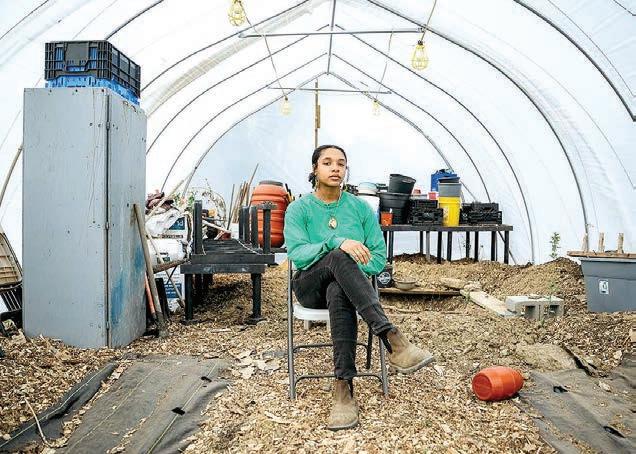
son recently succumbed to cancer, putting the weekly meals on hold.
The Sunday dinners intentionally celebrate the contributions of Detroit-based people of color, from a sweet barbecue sauce to local fish and chicken.
Communities create positive change when they invest in their residents, “not by increasing the development of houses but by increasing the bare minimum things that people need to survive,” Carr says. By promoting farming and good food, “we can decrease the amount of violence and pain and despair” — the deeply-rooted issues, she calls them. As the organization grows and expands its reach, she expects some of the people who drive by “and wonder why there are farmers in the middle of Detroit” will find inspiration to start food-centric projects of their own, like opening a grocery store or co-op.
People growing food need to know how to prepare it for sale, whether that be cleaning, weighing and packaging fresh produce for sale or turning harvested produce into a product, like salsa or jam. Incubator space provided by Deeply Rooted Gardens will help them do just that. Carr is in the process of transforming two houses on her property into licensed commercial kitchens, complete with “everything that a farmer’s heart desires.” There, farmers can rent space, experiment with their food, and attend classes.
Carr leads classes demonstrating how
Deeply Rooted Gardens targets “people who want to reconnect with the land, on any scale,” Carr says. She expects to see auxiliary chapters of the organization in other places eventually. For now, it will
The modern American food system is convenient and quick, Carr says, “but it doesn’t provide a rejuvenating, renewing relationship with the land.” Deeply Rooted Gardens promotes a slower, more deliberate connection to life’s essential elements, and to other humans, too, Carr says, adding, “All these things that start with occupying land as it is.”
By Jehan Crump-Gibson
Series: Matters of Life and Death
Some of us have loved ones living with a disability who receive government benefits like Medicaid and Supplemental Security Income (SSI). While SSI is important for food, shelter and clothing, Medicaid benefits are critical for medical and dental coverage for these loved ones. We certainly don’t want them to lose those essential benefits just because they receive an inheritance or other assets. The good news is that they don’t have to!
The law allows us to create special needs trusts (SNT) to hold funds for a person with a disability without putting their government benefits at risk. The SNT allows funds to be used for “supplemental needs.”
Supplemental needs are things that are not covered by government benefits but improve a person’s quality of life. These things can include medical and dental care beyond what Medicaid covers, recreational and travel activities, entertainment, therapies, specialized equipment, assistive technology, education, transportation costs and more. The SNT ensures ongoing support and care for a beneficiary living with a disability long after their loved one is gone.
Let’s take Barbara, who is only 43 years old. She has a son, Billy, who was diagnosed with Asperger Syndrome as a child. He is now 20 years old and lives with Barbara full-time. Barbara’s husband and Billy’s father passed away years ago.
Barbara ensures that Billy participates in behavior therapy, family therapy and takes an art class at community college. She was able to arrange for accommodations at the school, so that he could participate in an activity that make him happy. He loves art! She takes him on a trip at least twice a year to somewhere near an ocean or lake because he loves water.
Billy receives Medicaid benefits to cover his healthcare expenses; however, Barbara pays for the behavior therapy out of pocket, as Medicaid does not cover it. Barbara sacrifices for Billy to participate in this specific therapy, because he does well with it. She can see a significant positive difference in his behavior.
One day, Barbara finds out that she has an inoperable brain tumor. As she prepares for the worst, Barbara talks to her younger sister Angie about caring for Billy after she is gone. She isn’t rich but has a home, modest checking and savings accounts, a 401(k) and a life insurance policy with a $100,000 death benefit.
Barbara never updated the beneficiary on these assets after Billy’s father passed

away, so he is still named. Barbara recalls that someone at her church mentioned adding Billy to the property deed in case something happens to her, so that he’ll “always have somewhere to live.” Barbara goes downtown and files a quit claim deed with the county, doing just that. She never went to see an attorney and did not do any estate planning. Three months later, Barbara passes away.
Barbara’s sister Angie discovers that Barbara left the bank accounts in her name alone, so she must go to probate court to access those funds for Billy. He has therapy sessions coming up that require payment and tuition is due for another art class.
She schedules a consultation with a probate lawyer. The probate lawyer tells Angie that the bank accounts are the simplest of the issues. As Billy’s father is no longer living, Billy stands to inherit the 401(k) and the life insurance policy. He will also inherit the cash in the bank accounts and he was added to the house. If the house is sold, Billy will receive the proceeds from that sale directly.
As it stands, he will undoubtedly be disqualified from receiving his Medicaid benefits —meaning his medical and dental coverage. Now, Angie will have to petition the probate court for conservatorship, to get legal authority to make financial decisions for Billy. Once the conservatorship is set up, a petition will have to be filed asking the court to allow Angie to set up the same special needs trust Barbara could have set up when she was living.
The assets that Barbara left behind will need to be placed in that trust. Angie feels truly discouraged because it sounds like such a tedious process; but she has no choice but to spend the money and time to make it happen. Sure, Billy could simply inherit all the assets and get disqualified from Medicaid.
However, he is only 20 years old and with the staggering costs of healthcare, this simply isn’t a good idea. Those assets are not enough to provide lifetime healthcare for Billy. They certainly are not enough to provide supplemental needs for Billy’s accustomed manner of living, which is crucial now that his mother is gone.
If only Barbara had visited with a lawyer and planned before or as soon as she was diagnosed with her terminal condition… The moral of the story is that you should
not leave things to chance. No one has control over when and how they will pass away. This is why you plan for the unexpected. Contact an experienced estate planning attorney today!
Attorney Jehan Crump-Gibson is the Co-Founder and Managing Partner at Great Lakes Legal Group PLLC, where she concentrates her practice in probate and estate planning, business and real estate matters. Great Lakes Legal Group is a growing black-owned law firm serving clients throughout the state of Michigan and in federal courts across the country. Jehan has served as Faculty for the National Business Institute and the Institute of Continuing Legal Education concerning business, probate and estate planning matters. She is a legal analyst with Fox2 Detroit’s The Noon and the author of the book A Matter of Life and Death.

1.
2.
1.
inspection only.
2. The City shall not assume any liability to any person by reason of the inspections permitted by the
or the code adopted herein.
Full Stack Data Engineer
Positions offered by Ford Motor Company (Dearborn, Michigan). Note, this is a hybrid position whereby the employee will work both from home and from the Dearborn office. Hence, the employee must live within a reasonable commuting distance from Dearborn, MI. Develop scalable big data pipeline solutions in the Ford GCP Data Factory. EOE. Apply online: corporate.ford.com/careers
Senior Software Engineer
Positions offered by Ford Motor Company (Dearborn, Michigan). Note, this is a hybrid position whereby the employee will work both from home and from the Dearborn office. Hence, the employee must live within a reasonable commuting distance from Dearborn, MI. Develop web-based application in Java Springboot, Angular 16, JavaScript, CSS, and HTML. Utilize containerization technologies, including Docker, to manage and deploy search services to GCP Cloud. EOE. Apply online: corporate.ford.com/careers
for improving the
and
efficiency; among other duties. apply to job reference number R2025-0328 at https://phinia.wd5.myworkdayjobs.com/ PHINIA_Careers
Senior Software Engineer
Positions offered by Ford Motor Company (Dearborn, Michigan). Note, this is a hybrid position whereby the employee will work both from home and from the Dearborn office. Hence, the employee must live within a reasonable commuting distance from Dearborn, MI. Assist with Enhancement/New Development Projects (including research, analysis, functional/technical specifications, formal testing, and deployment) and Operations Support (triage and resolution). EOE. Apply online: corporate.ford.com/careers
Technical Anchor, Dealer Portal Support Team
Positions offered by Ford Motor Company (Dearborn, Michigan). Note, this is a purely telecommuting/workfrom-home position whereby the employee may reside anywhere within the U.S. Serve as the technical anchor for the CRM Dealer Portal product team. Facilitate the development, migration, and maintenance of our CRM dealer portal platform. EOE. Apply online: corporate.ford.com/careers
(StatePoint) An adjustable-rate mortgage (ARM) is often discussed as an option to help lower initial costs and increase flexibility, particularly in a high-cost housing market. However, it’s important to understand how these loans work, their potential risks, and strategies for managing adjustments over time.
ARMs 101
An ARM is a loan with an interest rate that will change throughout the life of the mortgage. In contrast, a fixed-rate mortgage has a fixed interest rate that is set when you take out the loan and does not change. In contrast to the stability of fixed-rate mortgages, with an ARM, your monthly payments may go up or down over time.
ARMs have two distinct periods:
The initial period: This period lasts between three to 10 years after you receive your loan, during which time the interest rate on your loan doesn’t change. It’s also known as the fixed-rate period. The most common ARM terms have initial periods of three, five or 10 years.
The adjustment period: Once the initial period ends, your loan will adjust. All ARMs have adjustment periods that determine when and how often the interest rate on your loan can change. Your adjusted rate will be based on your individual loan terms and the current market.
The name of your ARM will indicate the duration of the initial period and how often in a year your rate can adjust. For example, the most common adjustable-rate mortgage is a 5/6 ARM. This means you will have a fixed-rate period of five years. After that, you can expect your ARM to adjust once every six months.




(StatePoint) Women face unique financial challenges, such as career breaks for caregiving and gender wealth gaps.
CERTIFIED FINANCIAL PLANNER® professionals are offering insights into some of these challenges, along with tips to help women build wealth and achieve financial independence. The Challenges Wealth gap: Across all workers nationwide, women were typically paid 75 cents for every dollar paid to a man in 2023, a figure that’s held steady for decades. Given this persistent wage gap, it’s no surprise that the TIAA Institute finds that women have 30% less in retirement income than men, a big issue considering that American women live 5.8 years longer on average.

Caregiving roles: Women are often the primary caretaker to children and other family members, such as elderly parents, and are more likely than men to take time off from work to fulfill this role. This can impact long-term savings, professional advancement opportunities and Social Security benefits.
Health issues: While no one likes to imagine getting sick or feeling unwell, the unfortunate reality is that 1 in 8 American women will develop breast cancer in her lifetime. Other women’s health conditions, while not life-threatening, can also be costly to manage. Menopause, for example, associated with more than 100 symptoms, costs U.S. women $26.6 billion annually in medical expenses and lost work, according to the Mayo Clinic.
Financial abuse: Financial abuse is a common form of domestic abuse whereby a member of the household seizes control over another’s financial resources. While financial abuse transcends socioeconomic boundaries, the majority of victims are women.
The Solutions So how can women overcome these challenges? Here are several strategies for building wealth and holding onto it:
• Be proactive about potential health issues. Understand the price tag involved for care and adjust your budget accordingly. Have disability insurance to replace income should a medical condition sideline you, and a life insurance plan in place before a serious diagnosis to secure an affordable policy.
• Select a health insurance plan that meets your needs.
• Establish an emergency fund.
• Diversify your income streams.
• Begin investing in a well-diversified portfolio as early as possible.
• Build retirement savings by paying yourself first with each paycheck, maximizing contributions to tax-advantaged accounts.
• Create an estate plan to ensure your wishes will be met should you not have the capacity to speak for yourself.
• Educate yourself on finance and investing through workshops, books or by consulting with a CFP® professional.
• Reach out to the National Domestic Violence Hotline for support if you’re experiencing financial abuse.
To find a CFP® professional who can help you take these steps and work with you to overcome the unique challenges you face, visit LetsMakeAPlan.org. Understanding the financial challenges you could face and the solutions to overcome them can help you pave the way to a secure future.

ARMs also typically offer a rate cap structure, consisting of these three different caps, which limit how much your rate can increase or decrease:
Initial cap: Limits how much your rate can increase when your rate first adjusts. Periodic cap: Limits how much your rate can increase from one adjustment period to the next. Lifetime cap: Limits how much your
Let’s say you have a 5/6 ARM with a 2/1/5 cap structure. This means that after your initial period expires, your rate can increase
When to Consider an ARM
the initial period ends. Just be sure to account for refinancing costs, which are similar to the costs you pay when closing on your home purchase. Additionally, some ARMs require you to pay penalties upward of several thousand dollars for refinancing early.
How to Prepare for Adjustment
Because your interest rate could adjust higher, ARMs come with a level of uncertainty about future monthly payments. This is important because you are still responsible for making your monthly payments if your rate adjusts upward. Freddie Mac’s Adjustable-Rate Mortgage Calculator can help you determine how much your monthly payments may cost over the life of the loan. With this knowledge handy, you can budget ahead of time for even the highest rate adjustments allowable according to your loan’s terms.
To determine the right mortgage for your situation, lean on your lender or financial professional for guidance and check out the resources and tools available at https://myhome.freddiemac.com.
When it comes to mortgages, you have options, making it important to carefully consider the features and benefits of each type of loan.


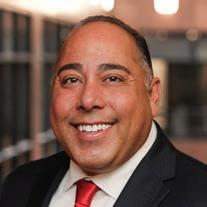
Ed Siaje President, Bank of


